Is “become an Omlet superfan” in your new year resolutions? We don’t blame you! Here’s all the super easy ways you can keep up with our special offers, competitions, videos, blogs and more in 2020!
Newsletter

Our weekly newsletter is jam packed with fun articles, information about exciting new launches and promotions, and reviews from customers. By subscribing to the newsletter, you will make sure that you’re the first one to know about everything Omlet! We also regularly deliver exclusive offers just for newsletter subscribers which we promise you will want to hear about. We can’t say too much, but it is very likely there will be an amazing Eglu offer coming up at the end of January ?
Youtube

The Omlet Youtube channel is a great place to explore our products. The informative and fun videos show all the groundbreaking features that customers love, with the added bonus of some very cute animals! By subscribing you will always be fully clued up on the latest Omlet innovations, and you will find plenty of useful information about keeping pets, like this one about making your Eglu ready for winter.
We also have helpful step-by-step videos showing you how to build all our products, resulting in fewer arguments and less frustration! You can have them playing in the background as you put together your pets’ new home, and it’s easy to pause or go back if needed.
Facebook Groups

The Omlet Chicken Keeping Facebook Group is a great place to meet other Eglu lovers. Our friendly customers share tips and tricks on keeping chickens, discuss the features of products and tell stories about their pets. Whether you’re a veteran crazy chicken lover or a total beginner, you’ll enjoy being part of Omlet’s Chicken Keeping Community!
Social Media

Integrate Omlet into your favourite social media feed and brighten up your scrolling time with cute pet pics, awesome new products, amazing competitions, promotions and much more! You will also get all the information you need to take part in the many competitions we will be running in 2020. You won’t want to miss out, so make sure you follow us today!
This entry was posted in Pets
This classy lady, all dressed up and ready for those Christmas parties!
This group of friends saying: Merry Christmas from our Pack to your Pack!
This little fellow, who is looking forward to helping Santa deliver all the presents!
This cutie who wants to Woof You a Hairy Christmas!
This beauty, who’s having a little paws between Christmas meals.
This lady, who knows the importance of decorating your home for the holidays!
This festive feline, who’s wishing you all a meowy Christmas!
This lovely lady who wants you to let Santa Paws know she would never be naughty!
And finally these best buddies, celebrating the holidays in style!

This entry was posted in Christmas
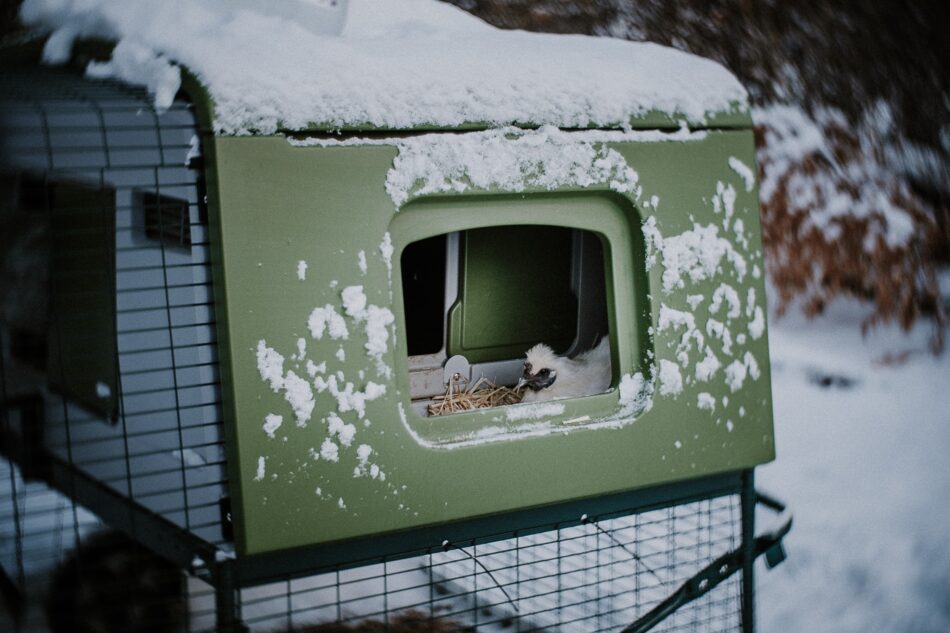
Snowy weather can bring great fun for all the family, but when it comes to our pets we need to take extra care to keep them happy and healthy (even if they love it!) Take a look at our snow safety advice, and make sure you’re prepared for whatever winter may bring…
Dry off damp fur and feathers
Check on your outdoor pets a few times throughout the day during periods of snowy weather and check they haven’t got too wet. Damp fur and feathers will take longer to dry during colder temperatures, making it difficult for them to warm up again. Indoor animals should also be dried off with a towel after being outside or going for a walk.
Clean paws of ice
For dogs and cats in particular, snow can get compacted into their paw pads and turn to painful cubes of ice. Use a towel or drying mitt to dislodge any chunks of snow and dry off their feet. Also take care when walking your dogs in snow, as salt used to grit the roads can be poisonous. Watch that they don’t stop to eat snow at the roadside and clean their legs and paws of any snow or dirt after their walk.
Extra food
Pets of all kinds will use more energy to keep themselves warm in winter, particularly in super cold, snowy spells, so they will benefit from some extra food. Although they will appreciate more treats, don’t be tempted to overfeed on these. Something nutritious will help them the most.
Extra bedding
Outdoor pets will need more dry bedding in their coop or hutch for them to snuggle into and keep warm. However, make sure their home is still well ventilated to keep fresh air moving through and prevent health problems. Read other ways you can get your coop winter-ready. Indoor animals might also appreciate an extra blanket or a cozy den for bedtime.
Potential risks
If you have a cat who still likes to go outdoors whatever the weather, be wary of the potential of antifreeze poisoning. Look out for symptoms such as vomiting, seizures or difficulty breathing and call a vet immediately if you think your cat may be ill. Find out more about anti-freeze poisoning here. An outdoor enclosure could also provide a solution for letting them play outside in safety.
Don’t forget about the wild birds in your garden!
Place a wide bowl or tray of water in your garden with something inside to float around (e.g. rubber duck!) to keep the water moving and prevent freezing. Extra wild bird food will also be appreciated!

This entry was posted in Pets

Great news! From now on you will be able to pay for your Omlet order in convenient instalments using the payment provider Klarna with a fixed interest rate.
That new chicken coop you’ve had your heart set on just got a whole lot more affordable, with Klarna you can spread the cost of your order between 6 and 36 monthly instalments. Dog crates, rabbit hutches and cat runs can all qualify, in fact any combination of products is fine so long as the total order is over $150.
If you choose Klarna as a payment method, you will see a pop-up window asking you to submit your details, you will then get an instant credit offering. Choose your preferred payment plan, enter your card details and complete the order!
Example monthly payments with Klarna are now also shown on the product pages themselves, so you can instantly see what the monthly payment amount could be.
Once approved, you make the monthly payments online or in the Klarna app using bank transfer or your card. Klarna will notify you when the payment is due.
You can read more about Klarna here.
This entry was posted in Offers and Promotions
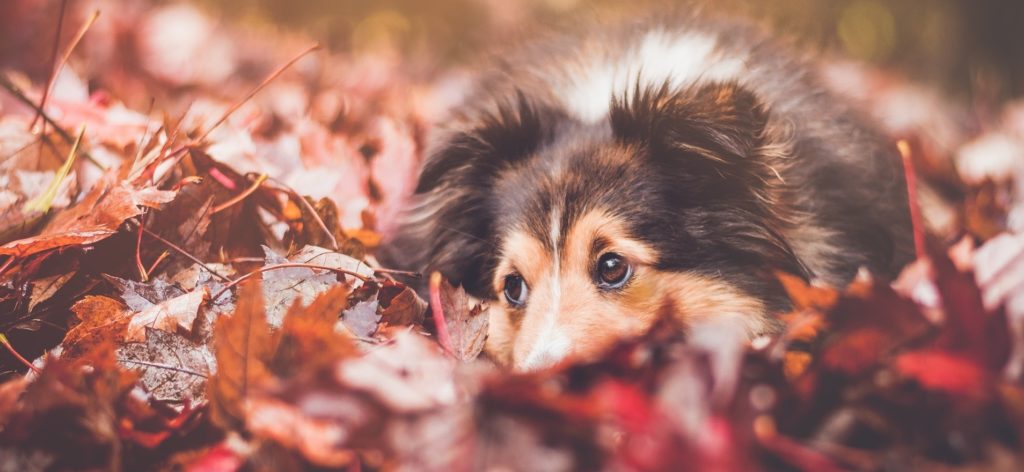
TURKEY
Let’s start with the most important thing – the turkey. The smell of the bird is going to be irresistible to pets, and they will try anything to get their paws on some meat. Never give your pet raw turkey, due to the high risk of salmonella from raw poultry. If you want to give your pet something, limit the treat to small amounts of cooked meat, but it’s best avoided completely.
The carcass will be almost as tempting, especially when it comes to dogs, but the bones could cause serious injuries to their digestive system. Never leave the carcass out on the kitchen counter or in a trash bag on the floor where your determined dog or cat can get to it. To minimise the risk of illness and injuries, it’s best to dispose of the carcass in a secure trash bag and take it out as soon as you’ve finished with it. Remember to add any wrapping or string that the bird came with or that you have used while cooking it. Don’t underestimate how nice that smell is to your pets, and how hard they will try to get to it!
OTHER HUMAN FOOD
Too much people food can cause stomach problems, and in bad cases inflammation of the pancreas. Our festive food is often too fatty, too salty and too sugary for pets (not to mention poisonous in some cases), and they are better off not having any of it.
If you want to spoil your pet for Thanksgiving, why not give them a new toy or a nutritious treat that has been especially designed for their species?
TRAVELS
If you’re crossing state lines or international borders, your pet will need an updated health certificate from your vet. Read up on the requirements for the states you will be visiting or passing through, and make sure your pet is good to go. Ideally this should be done a few weeks in advance so you have time to get an appointment with your vet.
While traveling, take regular breaks and make sure that you’re pet is safe and comfortable while you’re on the move. Depending on how long you’re going to be away for and what pet you have, it might be more convenient for both you and your pet to leave them behind and ask a neighbor or a friend to check in on them while you’re away.

UPDATED TAGS AND MICROCHIPS
Whether you’re travelling somewhere your pet hasn’t been before or you have guests going in and out of your home over the holidays, the risk of them getting lost or running away is much greater than normal. Make sure your pet is chipped and that the information is up to date.
SAFE SPACE
While some absolutely love it, a lot of pets can get nervous when lots of new, unfamiliar people visit. If your pet is on the nervous side you might want to make sure they have somewhere set aside for them where they can go if they’re feeling stressed or need a break from all the hustle and bustle.
A crate is a perfect place of safety for a dog, but a cat will also love a cosy den to curl up in. Give them their favourite toy and some water, and let them relax in their pet haven for a while.
RULES
If you have people coming over, make sure they are aware of the rules concerning the pets. Show them which doors and windows need to be shut, tell them when they should leave your pet alone and when it’s okay to approach, and let them know that they should not feed the pets leftovers.
Lots of plants and flowers that we use for decorations around Thanksgiving can be harmful to pets. Cats are often more at risk as they can reach most decorations, and are more likely to try to nibble a centrepiece, or that bouquet you put on the side table, but dogs and smaller animals like rabbits and hamsters can also suffer.
Try to choose flowers that are not poisonous, or that don’t cause gastrointestinal upset. When it comes to decorations such as pine cones, cornucopias, candles and flameless lights, be sure to keep them out of pets’ reach as much as possible. Never leave your pets unsupervised in a room with candles or an open fire.
This entry was posted in Cats
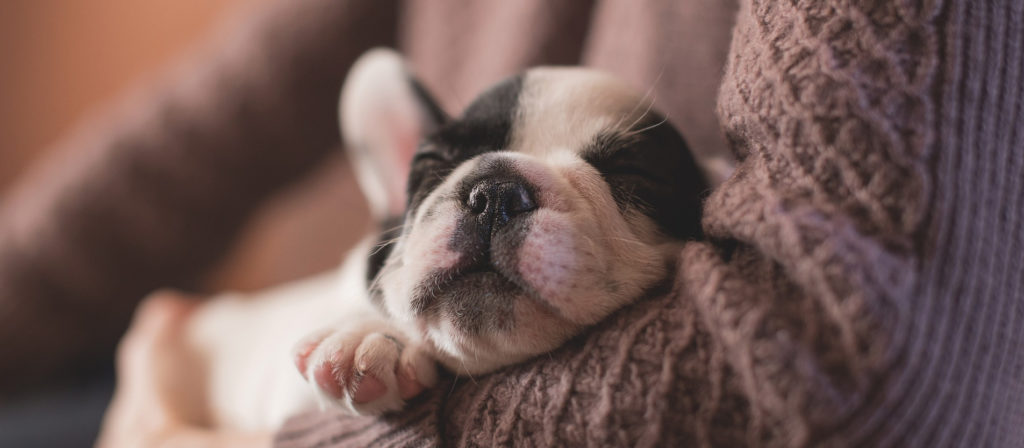 Naming pets can be difficult. Should you go for something highly original, something that describes the pet, or something that reflects your own personality? Should it be ‘safe’, picked from an online list of popular pet names? Or should it say something about the year the pet was born – perhaps a dog called Trump, a cat called Greta, or a budgie called Boris?
Naming pets can be difficult. Should you go for something highly original, something that describes the pet, or something that reflects your own personality? Should it be ‘safe’, picked from an online list of popular pet names? Or should it say something about the year the pet was born – perhaps a dog called Trump, a cat called Greta, or a budgie called Boris?
If it’s a family pet, parents often take the easy way out and ask the kids to think of names. We fool ourselves that we are being kind, inclusive parents, but in reality we’re just passing the buck!
Safety in numbers
Somehow, if there’s more than one new pet the floodgates of inspiration suddenly open. You can use the same letter – Maxi and Mini, Pixie and Pumpkin, or Arthur and Alfie. Or you can go for famous couples such as Pepper and George, Thor and Loki , Meg and Mog, Lennon and McCartney, Bubble and Squeak.
It becomes harder if there are more than two new animals to be named. A small flock of chickens, for example, may well start out with individual names, but chances are you’ll soon be referring to them simply as “The Chickens”.
The other definition of “safety in numbers” is “names used 1000s of times before”. Cats will always be called Tom, Fido will be used for Dogs, and Polly the parrot will remain iconic. And then there are all those lists of Most popular Pet Names. These change gradually as the years pass, just as popular baby names do.
A survey of 2018 faves, for example, suggests that Bella, Lucy, Lola and Alfie are the commonest dog names in the US. Cats are mainly called Luna, Bella, Milo and Loki. And if you have a parrot, chances are it’s named Charlie, Kirsty, Ollie, Bernard or Basil.
Small mammals tend to share popular names, and right now the most popular ones are Flopsy, Thumper, Luna, Cookie and Rosie (and Flopsy and Thumper, along with Peter, have been top names for rabbits for 60 years or more).
No Laughing Matter?
If you opt for an amusing name, you need to be confident you won’t regret the decision further down the line. You will find that names such as Brexit, Doggy McDogface and Smelly Cat soon pass their sell-by date.
If you want a pet name that will always raise a smile, without overdoing it, it’s best to choose something not usually used for pets at all. You’ll probably never tire of a cat called Gary, a dog called John and a parrot called Karen. It’s a fine line, though. Quirkier names such as Laptop the cat, Curtains the dog and Bread Roll the parrot may quickly lose their appeal.
 Things To Avoid
Things To Avoid
If you have a new dog, you should avoid giving it a name that resembles a command word. For example, Sid sounds like ‘Sit’, Levi sounds like ‘Leave it’, Walt sounds like ‘Wait’, Hal sounds like ‘Heel’, and so on. This is less of an issue with other pet species.
Anything rude or controversial is going to cause embarrassment – for you (when you have to use the name in front of the neighbours), and for the poor children forced to address their furry friends as Sexy Paws, Satan, or whatever.
It’s also short-sighted to give pets baby names. Yes, that puppy may well look like Tummykins, and that kitten may respond well to Tiny Fluff, but once they’ve become adults, it will sound a bit silly.
You should also spare a thought for vets and kennels/catteries too. Having a dog called Cholmondeley (pronounced Chumley), a cat that sounds like ‘catkin’ but is spelled Qatqin, or even rogue letters in the name, such as Jaxon, Klyde or Phreddie, can lead to confusion in databases.
Things To Fall Back On When All Else Fails
You could choose a name that describes your pet’s behaviour or appearance. Flash, Dash, Nibbler, Scratchy, Sooty, Rosy, Socks, Spot, Biscuit, Brownie, and so on. There are also the famous names – Bugs, Daffy, Sylvester, Tweetie Pie, Lassie, Laika, Marmalade, Felix, etc.
And then, of course, there’s that classic ‘get out of jail free’ card – the kids. All you have to do is pronounce judgement on whatever names they come up with, saying “try again” if you don’t like it. Once they’ve decided on a Snowy, Scooby, Simba or Marley, you can sit back with the satisfaction of a difficult job well done.
This entry was posted in Pets

Looking after a pet is a big responsibility. Not because it’s difficult or requires lots of time – neither of those are necessarily true – but because a pet is a living thing. It will rely on you as its friend and carer, its source of food, warmth and shelter.
If you can provide those things, keeping pets is without doubt one of life’s great pleasures. There’s often a big stumbling block though. If Mum, Dad or another well-meaning adult at home says you can’t have a pet, what’s the best way forward?
You could always accept it, of course – and maybe there are good reasons why, in your particular household, keeping a pet just isn’t going to work. For example, if you’re under 10 it’s not recommended that you should take full responsibility of a pet – you will need an older person to help out.
However, if the adult in question has simply not stopped to think about it, you’re in with a chance. For many of the commonest anti-pet arguments there are simple, practical facts that may help you change your parent’s mind.
Arm yourself with these, and you could soon be the proud owner of a new furry or feathered friend!
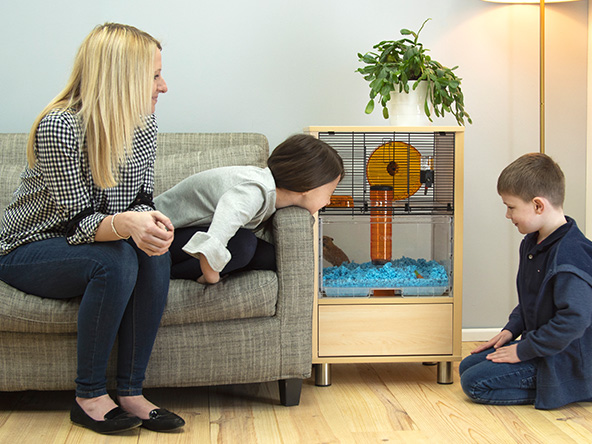
1 – Mom says: “Pets take too much looking after.”
You say: “It doesn’t have to be something that needs lots of training and walking, like a dog. A cat is pretty independent and easily house-trained. A small mammal like a gerbil or hamster only needs cleaning out once a week, and feeding them every day is simple. The same goes for budgies and finches.”
2 – Dad says: “We can’t afford to keep a pet.”
You say: “Small mammals are very cheap to buy. Or we could get a pet from a pet rescue center. They’re always looking for new owners, and we’d be helping out an animal in need, and supporting a very important local service. As for pet food, even a big dog will only cost a few pounds a week, and a small pet will spend a month nibbling through a $5 bag of food.”
3 – Mom says: “Yes, but what about those huge vet’s bills?”
You say: “Gerbils and hamsters don’t usually have many health problems in their short lives, and don’t need vaccinations and microchips like dogs and cats. And there’s also pet insurance – for a fairly low monthly premium, a pet can be covered for all kinds of potential problems. That way we can avoid unexpected vet’s bills.”
4 – Dad says: “Pets are too noisy.”
You say: “Okay, dogs are noisy, but they can be trained not to woof too much. Chickens are quite noisy, but we could run it past the neighbors, and I’m sure the promise of a few eggs would win them round! Pet birds make a lot of noise, but how about the gentle squeak of a guinea pig, or the soft purring of a cuddly cat? And rabbits, gerbils and hamsters are pretty much silent.”
5 – Mom says: “They make too much mess.”
You say: “Cats are very neat and tidy. Small mammals make their mess inside their enclosures, and I can clean that up every week.”
6 – Dad says: “Pets are smelly.”
You say: “Not if their cages are cleaned properly every week. And dogs can be shampooed.”
7 – Mom says: “All that cleaning out… I’m not going to do it!”
You say: “Modern hutches and chicken coops are really easy to clean, and I could definitely manage it myself. Take a look at the Eglu for chickens, and the Qute hamster and gerbil cages, and you’ll see what I mean.”
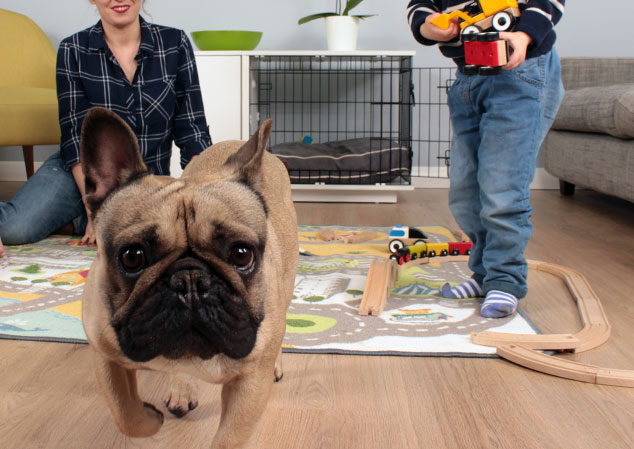
8 – Dad says: “You’re forgetting – someone at home is allergic to fur and feathers.”
You say: “There are hypoallergenic breeds of cat and dog, so let’s get one of those.”
9 – Mum says: “During term time there’s no one at home to keep the pet company.”
You say: “Some dogs are absolutely fine on their own for a few hours. Most cats are too. You just need to get one of the chilled-out breeds. And all small mammals and cage birds do just fine without a human around 24/7. Same goes for chickens – and you can even get automatic chicken coop doors for them these days.”
10 – Dad says: “But what’s the point?”
You say: “Pets are beautiful. They’re our best friends. Research shows that handling pets relieves stress. And chickens produce lots and lots of delicious eggs!”
This entry was posted in Pets

Pet ownership isn’t just for the young. In fact, people from all walks of life can enjoy the companionship and love that animals have to offer. There are a few extra considerations to weigh when choosing the best pets for older people – but with some planning and preparation, pets can help older owners feel young at heart.
Why pets are good for seniors
It’s a well-studied and widely-known fact that pets can be therapeutic. Many long-term healthcare facilities employ the use of dogs, cats, and other tame animals in programs that inspire, uplift, and encourage their occupants. Pets offer love and affection with no strings attached, and no questions asked – giving many people a boost in mental health, an air of peace, and a feeling of importance.
For seniors, pets can bring companionship, a sense of purpose, and even improve health conditions or concerns. But great thought should be put into selecting the right pet, planning for their future, and knowing when and from whom to solicit help in caring for them when the time comes.
The best pets for older people
Whether you’re looking for a pet to enjoy during retirement, or thinking about gifting a loved one with an animal companion, it’s important to keep in mind:
- The physical ability of the owner
- Time and space requirements of the pet
- Average lifespan of the pet
Pet care shouldn’t burden the owner, nor should it be compromised when owners are no longer able to perform the tasks necessary for their health and wellbeing. It’s a good idea to have friends, family members, or other resources in place if an elderly owner should need assistance with their pet. Additionally, pets that might be perfect for elderly individuals can come with a few caveats to consider.
Cats
Arguably one of the easiest companions, cats are at the top of the list when deciding on a pet for older people. Some breeds of cats are more easygoing than others, but in general, most adult cats make excellent companions for those getting on in years.
Cats don’t require much space – they’re happy to share a home with their owners. Having a natural desire to bury their eliminations, litter box training is quick and easy, and the vast majority of indoor cats have mastered this skill by the time they’re a few months old.
Felines are also known for being very self-sufficient. They can be free-fed, meaning their food can be left out and refilled as needed. The majority of a cat’s day is spent sleeping, with the average cat snoozing up to 18 hours or more each day. Older cats can be readily found at shelters, rescue organizations, or adoption events – most of which will already be spayed or neutered and vaccinated.
Feline factors:
- Kittens have lots of energy, and can easily (though usually, accidentally) break the skin of older people with their teeth and claws
- Cats have long lifespans, averaging 12-18 years – though some can live up to 20 years and beyond
- Litter boxes will need to be cleaned regularly
- Vaccines are necessary for cats, so vet visits will be inevitable
Dogs
Dogs are a close second behind cats when considering ease of care and companionship. Their loyalty and devotion is hard to match, and their care is easy and straightforward. Dog breeds are diverse and numerous, giving dog owners many choices when selecting their companion.
Older dogs are typically “set in their ways”, and are usually housebroken, spayed or neutered, and fully vaccinated. Younger dogs can be a good choice for older people, so long as they have learned the basics of housetraining and obedience, and have finished teething – usually by 8 months of age.
For owners with specific health concerns, service dogs might not only be wonderful companions, but life-saving. Many dogs can be trained to alert owners to events like high blood pressure episodes, impending seizures or fainting spells, or low blood sugar levels. So, if you’re looking for a pet to accompany an aging loved one, a dog trained to alert them to medical events can be an excellent option.
Canine considerations:
- Puppies require a lot of work to housetrain, and will be busy teething on furniture, shoes, human hands and feet, and anything else they can get their mouth around
- Exuberant breeds, young or untrained dogs may jump up and knock older people off balance
- Dogs will need to be let out in an enclosed yard or walked on a leash multiple times per day to relieve themselves and exercise
- Small dog breeds can live 15-18 years on average
- Certain breeds have coats that may require regular grooming
- Vaccines are required for dogs, so vet visits are a necessity
Chickens
They may not be a conventional pet, but chickens are great for people who love to spend time outdoors. Starting a flock during retirement is an excellent way to enjoy fresh air and keep your mind and body active. And, thanks to recent recognition, hens are now allowed in many urban areas.
Chickens do require their own companions, so you’ll need to keep at least 2-3 hens at a time. Surprisingly, chickens don’t require an excessive amount of space, with most urban backyards having plenty of room. And, hens are very self-sufficient, able to free feed and forage for their meals.
Flock factors:
- Chicken-keeping can be physically demanding
- Hens are limited to the outdoors
- These birds of a feather must flock together in a group of at least 2-3 hens
- Chickens have a relatively short lifespan, averaging 4-6 years
- Eggs will need to be collected regularly
Small birds
Small birds can be appealing companions for senior owners. Their lifespans aren’t as long as parrots and other larger birds, and their care is more simple. Choices like parakeets, canaries, and finches are good options for older adults.
These birds are easy to care for, beautiful to look at, and provide songs (and potentially even words in the case of parakeets) as feedback to their caretakers. Elevated bird cages make it easy to view the inhabitants, and are easy to clean.
Parakeet parameters:
Rabbits and guinea pigs
Small animals like rabbits and guinea pigs are other pets for older people. They’re fairly self-sufficient, thriving on a free-fed diet of pellets and hay, and are entertaining to watch. Easy-to-clean outdoor rabbit and guinea pig hutches help reduce indoor odors and give an opportunity for their owners to spend more time outside. Rabbit and guinea pig life spans are similar, with 8 years and 6-7 years being their averages respectively.
Rabbits and guinea pigs are soft, full of character, and are very animated animals. They’re a joy to watch, and can interact with their owners much like a dog or a cat would. Rabbits can be kept individually so long as they have plenty of interaction with their owners, but guinea pigs are highly social and always do better in bonded pairs.
Small pet special considerations:
- Rabbits and guinea pigs may be difficult for older people to pick up and handle
- Rabbits in particular have sharp nails and powerful legs, which may accidentally injure those with thin skin or who bruise easily
- Guinea pigs must be kept in pairs, and can be very vocal
Pets that aren’t perfect for older people
For many aging people, having pets is about companionship. A bond between a human and animal is a powerful thing, but like all relationships, sometimes there are not-so-great matches made. For example, an older person who has limited mobility or flexibility should probably not embark on a potty-training journey with a rambunctious puppy. Or, an elderly person seeking a warm lap-napper would benefit more from an older, calm cat than an active kitten.
Other pets that aren’t the most companionable for older people include:
- Reptiles
- Insects
- Fish
- Rodents
- Large birds like parrots
- Exotic pets like hedgehogs, sugar gliders, and ferrets
While each pet has something unique to offer to their owners, these animals require specific care and attention that is probably not suitable for someone seeking companionship over novelty.
Enjoying pets with Omlet
No matter what phase of life you’re in, our pet products bring joy into the lives of pets and their people. From luxury dog beds that add character to your home, to litter box furniture that is both discrete and functional, your pets can bring both companionship and charm to your home. Our designs deepen the bond between animals and humans, making their connection lasting and wondrous.
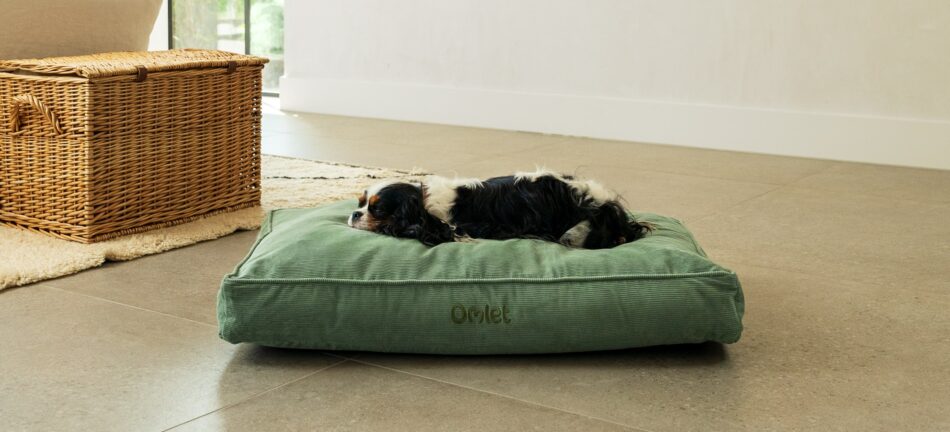
This entry was posted in Pets
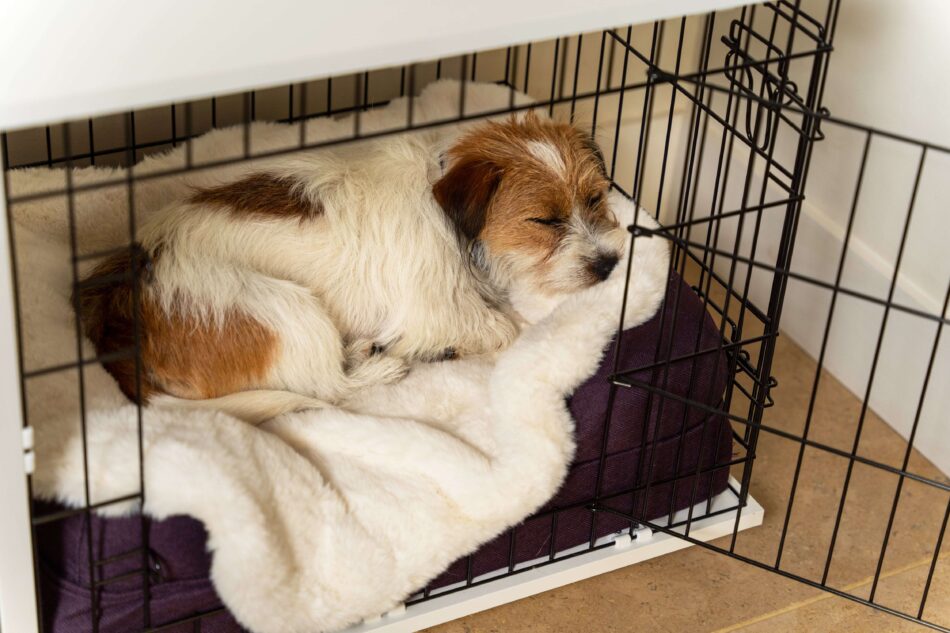
Moving can be stressful for everyone involved – including your pets. Thankfully, there are a few things you can do to minimize pet stress when moving. From furry to feathered family members, we’ve got solutions to keep your pets’ stress levels at a minimum during this big transition period.
Preparing for the move
Packing your pets’ essentials is an inevitable part of moving – but it’s something that you should try to time just right to help reduce the amount of stress they’ll endure. Try to pack your pets’ items last so that they’ll be first off of the moving truck when you get to your new home. If possible, keep comfort items like dog beds and cat beds available throughout your move.
Small pets like hamsters and parakeets should be kept in their cages for the entire move if at all possible to reduce stress. The Qute Hamster Cage has a removable bedding tray that can double as a moving container, and the Geo Bird Cage can be transported without being disassembled (aside from removing it from the optional stand).
Outdoor pets like chickens, rabbits, and guinea pigs pose a slightly more challenging endeavor. Chicken coops should be left assembled for as long as possible so that your flock can stick to their routine. Large items like the Omlet Walk in Chicken Run should be moved to your new home and reassembled as soon as possible, leaving your flock to stay in their coop’s attached run, or inside of chicken fencing in the meantime.
Rabbits and guinea pigs can be housed indoors or in small pet playpens temporarily during a move. A guinea pig playpen or rabbit playpen can comfortably house your pets for a day or two while you finish packing their things.
Temporary accomodations
If your move will be local, you may also want to consider leaving your pets with a friend or family member, or boarding them at a facility while you set up their things at your new home. Or, in the case of chickens, you could move your flock to your new home and have a chicken sitter watch them while you continue to pack and move the rest of your belongings.
Take extra care with cats, as they are more likely to experience deeper feelings of stress over moving than other pets. Hiring a cat sitter may be a good option, but only if your cat can remain at your current home until the day you move into your new home. Having someone check on them in a strange new home without you there is a sure way to stress out your cat.
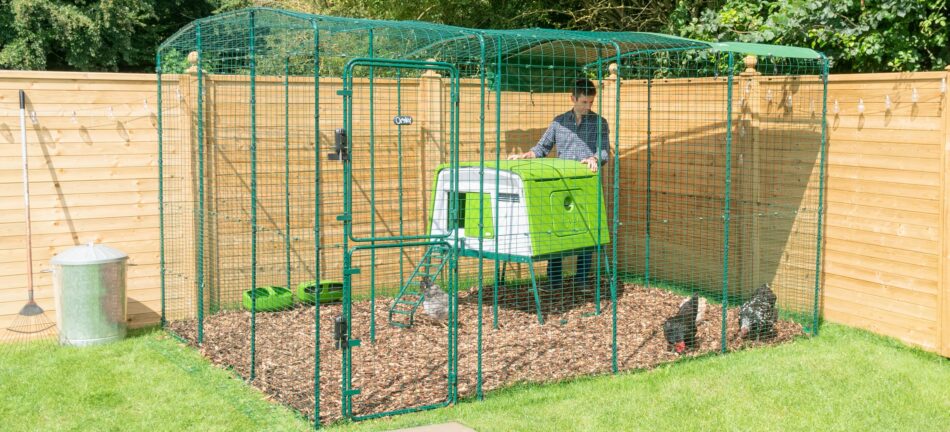
During the move
Some pets enjoy traveling – others would rather be anywhere else, doing absolutely anything else. Thankfully, there are a few ways to help hit the road with your dog, cat, chickens, or small pets:
- Introduce the concept of a car ride to your pet well in advance of moving day. For dogs and cats, this could be taking them to the car and feeding them special treats. For chickens, rabbits, and guinea pigs – practice handling them and placing them in their travel containers with lots of treats. These practice sessions should be short and sweet, gradually building up to short car rides.
- Never let an animal roam freely in your vehicle. Ideally, all animals should be transported in travel crates, but some dogs especially may be too large for this to be a feasible option. Dog seat belts and harnesses are available, and are an excellent way to keep your pup safely where they should be in your vehicle.
- Small pets in crates or cages should be covered as long as they’re able to receive ample ventilation and airflow. Blocking out visual stressors will help your nervous pets travel better.
- If the trip is long, take breaks every hour or two to offer your pets water. Don’t attempt to offer food to traveling pets, as this could upset their stomachs. Dogs should be taken outside on a leash at each stop to stretch their legs and relieve themselves.
Welcome them home
Once you’ve finally made the transition to your new home, try to set up your pets’ things right away, and as close to how they were used to seeing them. If your dog’s water was in the kitchen, try to put it in your new kitchen. If your chickens’ coop was under trees before, try to find a shady spot in your new backyard. The idea is to make as few changes as possible to your pets’ routine and preferences.
Place indoor pets in a safe room while you unload their things. Make sure your cats, rabbits, or guinea pigs have access to a litter box during this time. Chickens should be placed in their run as soon as possible. Once everyone is settled, try offering a small amount of food and fresh water.
When you’re ready to introduce your pet to the new house or yard, make sure:
- All exterior doors and windows are closed to prevent accidental escapes
- Any gates or access points to your yard are closed
- Dogs and cats have their collars and identification tags on
If your cat is used to going outdoors, prevent them from going outside for the first two weeks of being in your new home. This will firmly establish that this new dwelling is “home”, and help prevent roaming.
Give all pets plenty of time to settle in. Small pets like parakeets and hamsters should fall right back into their usual patterns once their cages are in their permanent locations. Rabbits and guinea pigs may spend more time in their hutches, but as the days go on, they’ll venture out to take in their surroundings. Chickens may not lay eggs for the first few days following a move, which is completely normal under the circumstances.
Making a move with Omlet
Our products make it easy to take a piece of home with you wherever you go. Whether it’s your dog’s favorite blanket or your cat’s preferred bed, your pets can carry a comfort item with them during a move or during a temporary stay with friends. From chicken tractors and mobile rabbit and guinea pig hutches that you can wheel onto a trailer with ease, to take along hamster cages and bird cages, we make moving just a little bit easier so that you can get back to the good life with your pets as quickly and safely as possible.
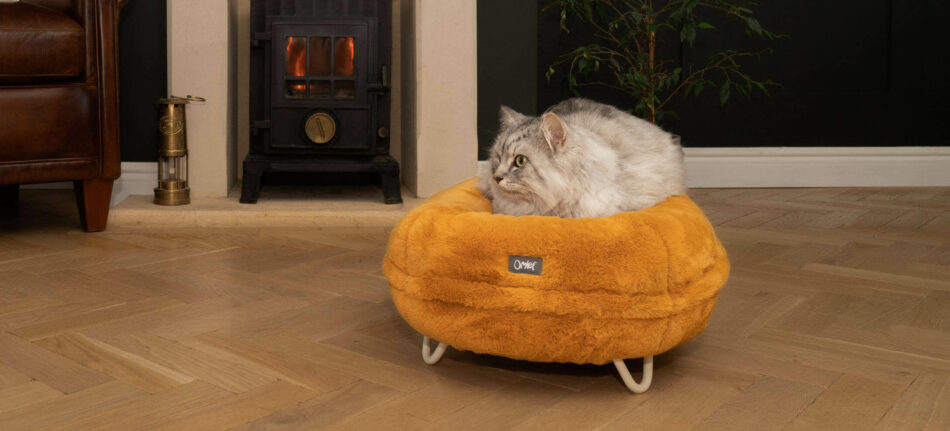
This entry was posted in Pets
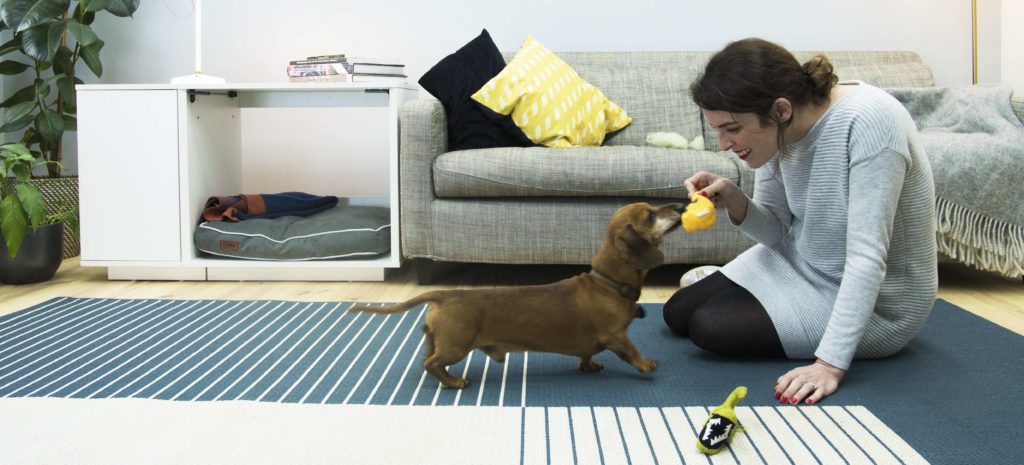
The arrival of a baby in a household turns things upside down. That’s certainly how it can seem to your pets. A dog may find there’s less time for walks and playing, and a cat may suddenly be ousted from her favorite sleeping places in the bedroom or on your lap, due to the presence of the baby.
It’s important to get your pets used to the idea of having the newcomer around, along with the changes in routine that go with it. And ideally the preparation needs to start before the baby is born.
Prenatal Pet Training
In the months leading up to the birth, spend slightly less time with your cat or dog – particularly if they are used to lazing in your lap or sitting by your feet demanding attention.
If your dog is not fully trained at this point, fill in the gaps with some training sessions. Get an expert in to help out, if necessary. Your dog needs to know the basic ‘Sit’, ‘Stay’ and ‘Leave it’ commands, at the very least. It’s essential that the humans in the house reinforce their roles as Alphas in the pack.
A new baby will bring new sounds and smells to the house. You can get your pets ready for this by inviting mums and dads with babies or toddlers to call in for coffee. Play a recording of a crying baby to acclimatize pets’ ears, and switch on any noisy new toys, mobiles, swings or other baby-related apparatus. Let your pets sniff a nappy and a cloth with a few drops of baby oil on it. Familiarity is half the battle.
Get Your Pet Vet-Ready
A neutered pet is a calmer pet, and less likely to bite. This is especially true with males. When neutered, they are less likely to view the baby as a rival. Arrange for a vet to perform the operation, if the pet is not yet neutered. And while you’re there, make sure Puss and Fido are up to date with their vaccinations, worm-free, and generally in tip top health.
Reset Schedules
Babies bring lots of unpredictability to a household, and old routines soon break down. There’s nothing wrong with this, but a pet who’s set in his ways may not take kindly to sudden change. Break him in by varying feeding times, blocking off no-go areas with a baby gate, or perhaps hiring a dog walker.
If the human mum-to-be has always been the pet’s chief companion, it’s handy if you can introduce another ‘favourite’ into its life. This could be a partner, older child or friend – anyone able to spend quality time with the animal.
Introducing the Baby
Before letting a dog or cat see the baby, let them sniff a blanket and a soiled nappy. Try not to show any nervousness when bringing the baby into the house for the first time, as pets will pick up on the bad vibes.
To make the first introduction, sit with the baby in your arms – ideally in a ‘neutral’ room, one where the pet doesn’t usually go – and let the dog or cat approach in its own good time (and one at a time, if you have multiple pets). Don’t force the issue. Have some treats ready to reward good behavior.
You can reinforce the positive associations by treating a dog whenever it’s around you and the baby. That way your pet will come to associate the baby with good things (i.e. food!) A cat will need less fuss in this respect, and will simply equate the baby with you, logging it as something not to worry about.
Whenever there’s any interaction between baby/toddler and pet, make sure there’s an adult around to keep an eye on the situation.
 Special Notes For Cats
Special Notes For Cats
A docile cat needs to get used to the new baby, and to keep away when it’s asleep. A more flighty cat should simply be kept away. Toddlers seem to have an instinct for grabbing handfuls of pet fur, and a nervous cat may react by scratching. A cat flap with a lock can be handy in the early days, to keep puss outdoors at key times.
Many cats dislike a baby’s crying, and will disappear when the screaming begins. This is very handy! Make sure there’s a quiet, safe spot for them, away from the mayhem. The Maya Nook is a perfect solution to give your cat some privacy.
Cats feel exposed and nervous when they eat, so you should keep a toddler away from the place where your pet is feeding. It should also go without saying that you should prevent young ‘uns from rummaging in the litter tray too!
Special Notes For Dogs
All dogs will need to be well-trained, in a situation where trust is so fundamental. Some dog breeds are very rarely going to be friendly with children, though. A dog bred over hundreds of years for aggression is NOT a dog you should have in the family home. ‘Snappy’ breeds such as Jack Russel, Dachshund or Chihuahua can be problematic too, but you probably know your dog best.
A treat-based puzzle toy such as a Kong ball is a useful distraction. You can give it to your dog while you spend time tending to the baby, to divert the pet’s attention.
It’s important not to abandon dog walks, as that will lead to doggy stress and frustration. It’s a case of ‘business as usual’, where ‘usual’ has simply undergone a few changes.
The dog/child relationship is a two-way process, and youngsters need training too. Teach them to be gentle with the dog, and they will have the basis for a good relationship.
And the importance of that relationship shouldn’t be underestimated. Children learn lots about friendship, respect and responsibility from interacting with animals. There is also evidence that allergies are less of an issue in kids who have been brought up with pets.
So – you’ve replaced your ‘pet baby’ with the real thing. That means big change. But when handled properly it’s a positive change, the beginning of a new chapter in the happy family home.
This entry was posted in Cats
Those who have lost a beloved pet will know the pain can be as heart wrenching as the loss of a family member or friend. For many couples, the family pet becomes another child, just one with four legs and a tail who doesn’t answer back. Many of us also find comfort and friendship in our pets throughout the highs and lows of day to day life, so the passing of a pet can be extremely painful.

It’s okay to be sad
Take the time to process what has happened and allow yourself to be sad. This is especially important if you have children who may be experiencing this kind of loss for the first time and might struggle to understand.
Pet owners often have to make the difficult decision to have their pets put to sleep when their health deteriorates too far to be helped. This adds another aspect to the grief as some may feel guilty for having to make that decision, or as though they could have done things differently. Discuss the events with your vet, as they will be able to reassure you that you did the right thing.
Don’t feel ashamed for any sadness you feel. Many people may not understand or be sympathetic towards the sadness when we lose a pet, but that doesn’t mean you are not allowed to feel upset. If you think it would help you to take a couple of days off work to grieve, do so. Pets who have been in your home for years leave a big hole, and feelings of loneliness and emptiness are completely normal.
Confide in your family and friends about how you feel, but if you do not think they understand, seek the support of grief support helplines.
If they were your only pet, consider moving your pet’s bed, food bowls, toys and other belongings into a garage or shed so they are out of sight. Throwing these in the bin straight away can be difficult so don’t rush, just put them away so there is one less reminder in the home.
If you have another pet, keep a close eye on them for signs of depression and loneliness. Consult a vet if you believe your pet’s behavior has changed drastically and shows no sign of improvement.
What next?
Some people choose to rescue or adopt another pet soon after the loss, as the home can feel empty without them. However, others find this feels too much like attempting to replace them. Consider rescuing a different type of pet, e.g. if you have lost a dog, why not rescue a cat instead. That way you are not at all replacing your previous pet, but you are offering a cat in need a happy home.
We are all guilty of taking lots of photos of our pets, and this is the time to put those photos to use. Find your favorites and prepare a photo album, or get a canvas printed, so they can still be a part of your home. Other things you could do in memory of your pet are plant a tree or flower in their favorite garden spot, read or write a poem, make a donation to a pet charity which means a lot to you, or volunteer at a local rescue shelter.
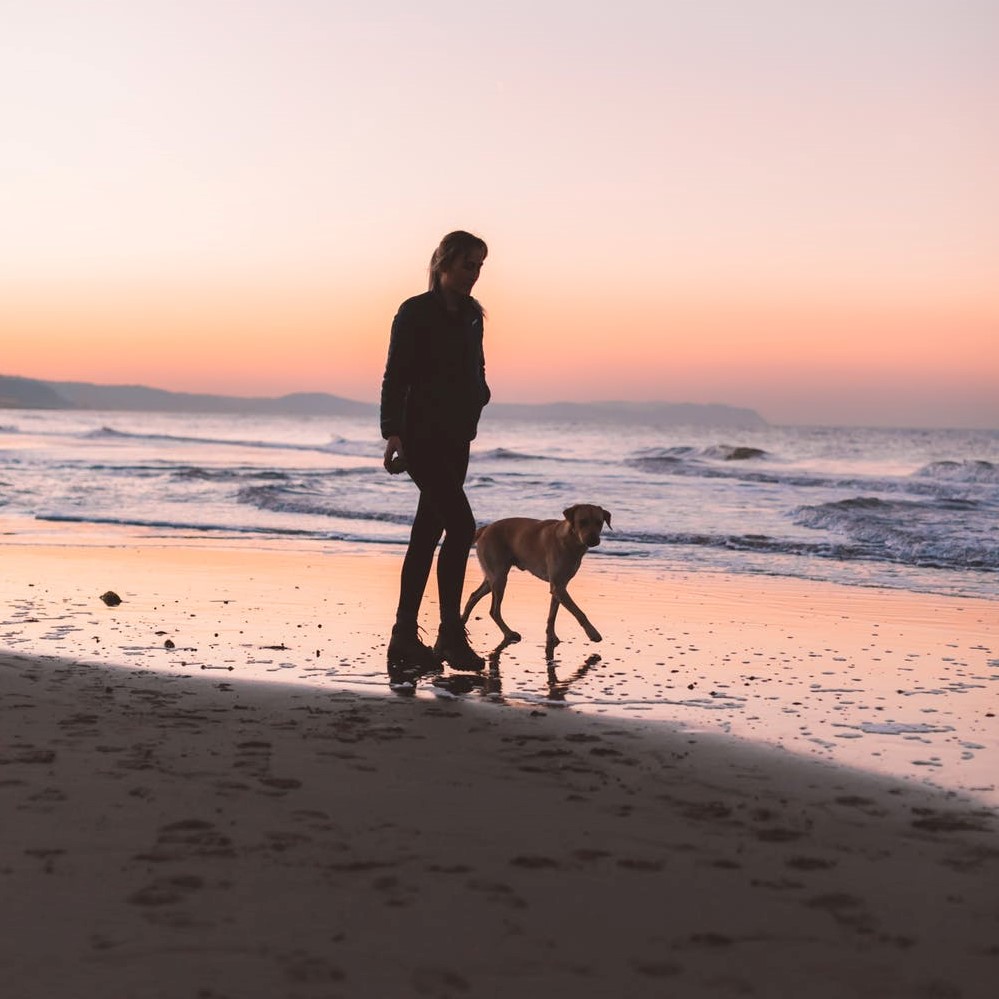
Pawprints Left By You – By Vayda Venue
You no longer greet me
As I walk through the door,
You’re not there to make me smile,
To make me laugh anymore,
Life seems quiet without you,
You were far more than a pet,
You were a family member, a friend,
A loving soul i’ll never forget.
It will take time to heal,
For the silence to go away,
I still listen for you ,
And miss you everyday,
You were such a great companion,
Constant, loyal, and true,
My heart will always wear,
The pawprints left by you.
This entry was posted in Dogs

Thankfully, animal ill health is very much the exception rather than the norm. Many pets go for years suffering nothing worse than the occasional tick, flea or minor wound.
However, if illness or injury strike you can cut the stress by making sure your pet first aid kit is well-stocked and ready to go. Many illnesses will require diagnosis and treatment from a vet, but there are minor problems and non-medical issues that you can easily address yourself.
What you need very much depends on the type of pet you have. But let’s start with some general med-kit classics.
No First Aid Kit Is Complete Without…
- Bandages – self-adhesive or crepe, 2.5 and 5cm width
- Non-adhesive absorbent dressing pads (5cm x 5cm, or smaller for guinea pigs, rabbits, etc)
- Sterile absorbent gauze
- Sterile wipes
- Antiseptic ointment and antibacterial spray
- Surgical tape
- Cotton wool rolls, pads, balls and buds
- Tough scissors – a blunt-ended pair, and a small curve-bladed pair
- A thick towel or blanket
- Disposable gloves
- Tick-remover tweezers
- Iodine, for treating small wounds (including tick wounds)
- Flea and lice comb
- Nail clippers
- Sterile eye wash – for clearing dust, dirt or smoke from the eyes
- A full water container – for washing cuts and dirt, and for hydration
- A mild detergent – for use with the water
- Styptic powder – this stops bleeding from broken nails
- Cornflour (cornstarch) – for staunching minor cuts and abrasions
- Diphenhydramine (or Benadryl) – an antihistamine for mild allergic reactions
- A pet thermometer
- A card with your vet’s phone number, and other useful emergency numbers
- Treats – very useful for rewarding and reassuring a pet who has just been bandaged, tweezered or manhandled in some other undignified manner!
- You should also keep a supply of species-specific flea and mite powders and worming tablets
- For smaller pets, an oral syringe is useful for giving water or liquidised food to an animal that refuses to, or is unable to drink
- A magnifying glass can be useful too, for examining wounds or infestations on rodents, rabbits and cage birds.
Cats and Dogs

Additional items useful for cats and dogs include Elizabethan collars, to prevent your furry friend biting at wounds or dressings. The collar size will vary depending on the size of your pet.
A muzzle is also a very useful inclusion in any dog first aid kit, as even the most placid pet can become afraid and defensive when in pain. You can buy face masks for cats too, with a similar purpose.
First Aid For Birds
Many of the items in the general list above are useful for treating birds. Additional items for avian first aid include a bird net, specifically made for capturing frightened or untamed pet birds in cages and aviaries.
A styptic pencil is an essential tool for staunching wounds resulting from broken feathers or claws. Unlike mammals, birds do not have efficient clotting agents in their blood, and what may appear to be a relatively minor wound can result in death, simply through bleeding. The styptic will swiftly staunch the flow.
A cage sanitizer will help minimize the risk of contagious disease spreading, should one of your birds fall ill. There are various brands available in stores, and your vet will be able to advise you on the most suitable preparation for your particular species of bird.
It is also possible to buy Ivermectin drops from your vet. This medicine kills internal and external parasites, along with the mites responsible for scaly face and scaly leg. It is also used for fur, ear and mange mites and lice in small mammals such as hamsters, gerbils and guinea pigs.
It’s a good idea to keep some wire-cutters in your med-kit too, as birds can sometimes become entangled in loose wires or hangings intended for suspending toys or treats.
Crop needles and blood-feather tweezers can also be useful, but these are precision tools that require expertise to use. Ask a vet or bird breeder for more advice.
DIY is Not Always Best
Pet first aid is fine for minor problems, but in emergencies it is only a stop-gap solution before consulting a vet. Any pet illness needs proper medical care.
A well-stocked first aid kit will, however, save you a lot of time and worry when confronted with pet parasites, small wounds and other conditions that can be tackled with a swift and effective DIY approach.
This entry was posted in Pets
Summertime… Beach stays, trips abroad, hikes in a National Park… It is a great opportunity to take a break with your family and keep daily stress at bay. You book a lovely hotel with your other half, you read a map with your children asking them where they want to go, you pack your suitcases, you… Wait! Aren’t you forgetting someone? “Babe, what about the cat? Is he coming with us?!”
Most pet owners tend to forget about it: having a pet means new responsibilities and taking care of them when you go on holidays is one of them. Unfortunately, too many people still ignore it. The months of June, July and August are critical since many people seem to struggle when it comes to taking care of their pets while also going on holiday. Read our tips below to make sure your pets will have a great time this summer, just like you!
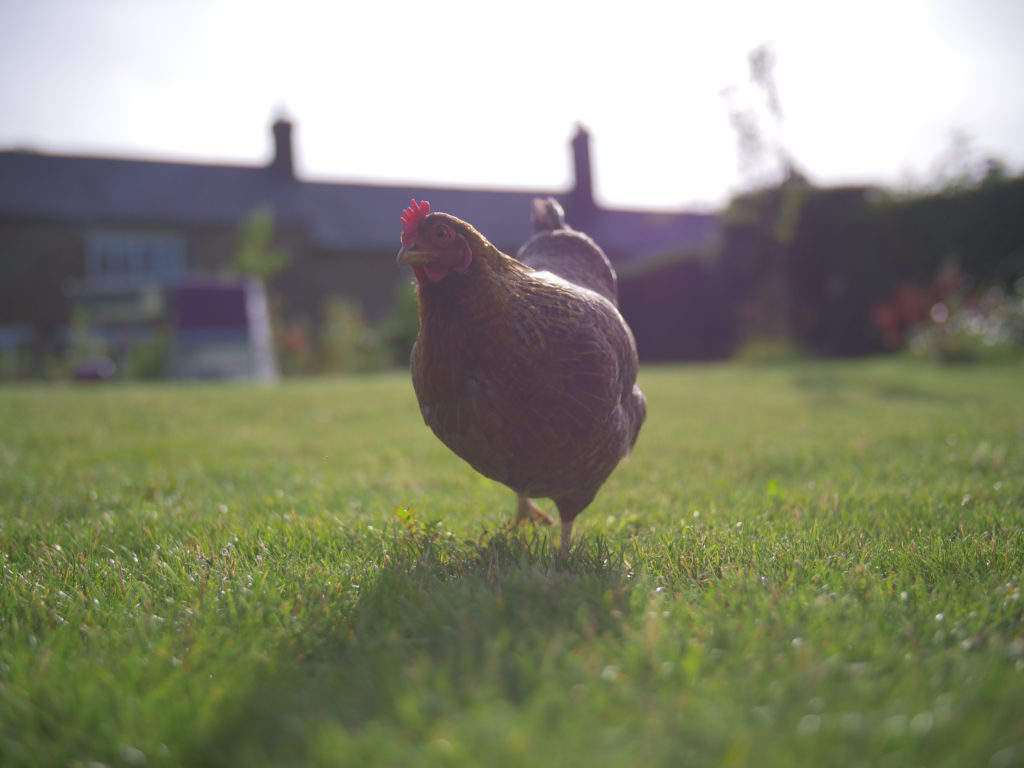 CHICKENS
CHICKENS
You might be an adventurous Frenchman aiming to sail around the world with your hen (https://www.bbc.com/news/world-europe-36475672). However, in all other cases, we recommend that you do not take your chickens on holidays with you. The best thing to do is to ask some friends or neighbors to take care of them while you are away, offering them to help themselves to eggs. If you are lucky enough to have an Eglu Cube on wheels, you can even move your coop directly into your neighbor’s backyard!
HAMSTERS, GUINEA PIGS AND RABBITS
Just like with chickens, it is better to leave your hamster, rabbit or guinea pig at home and ask a friend, ideally someone they already know, to come and look after them. If you still decide to take them with you, or if you don’t have any other choice, be very careful with temperature change. These smaller pets are extremely sensitive to it and a sudden temperature change could be fatal. While in the car, make sure that they are neither too hot (do not leave them next to a window or in a parked car) or too cold (do not put them in front of the air con). You also want to check that nothing is at risk of falling and hurting them in the cage: take away the bottle and the feeder and stop regularly to give them some water and food. Remember that rodents and rabbits are very shy animals that like to have their own routine and tend to struggle with change.
CATS
You can definitely take them with you, but in most cases you don’t have to: cats are independent animals that can take care of themselves for a few days. Fill their bowls with food and water before leaving. If you are away for less than 10 days, ask a friend to come and check on them (one or two short visits a day should do).
If you are away for more than 10 days, it is better to leave your cat with some relatives, preferably people who already know your cat and who don’t have any animals that the cat won’t get along with. You can also put your cat in a boarding kennel. However, keep in mind that this can be risky since your cat could feel abandoned (new place, new faces…) and get depressed. Before taking them to the cattery you can give them some soft and natural tranquillizer, like Bach flower, to help them adjust.
DOGS
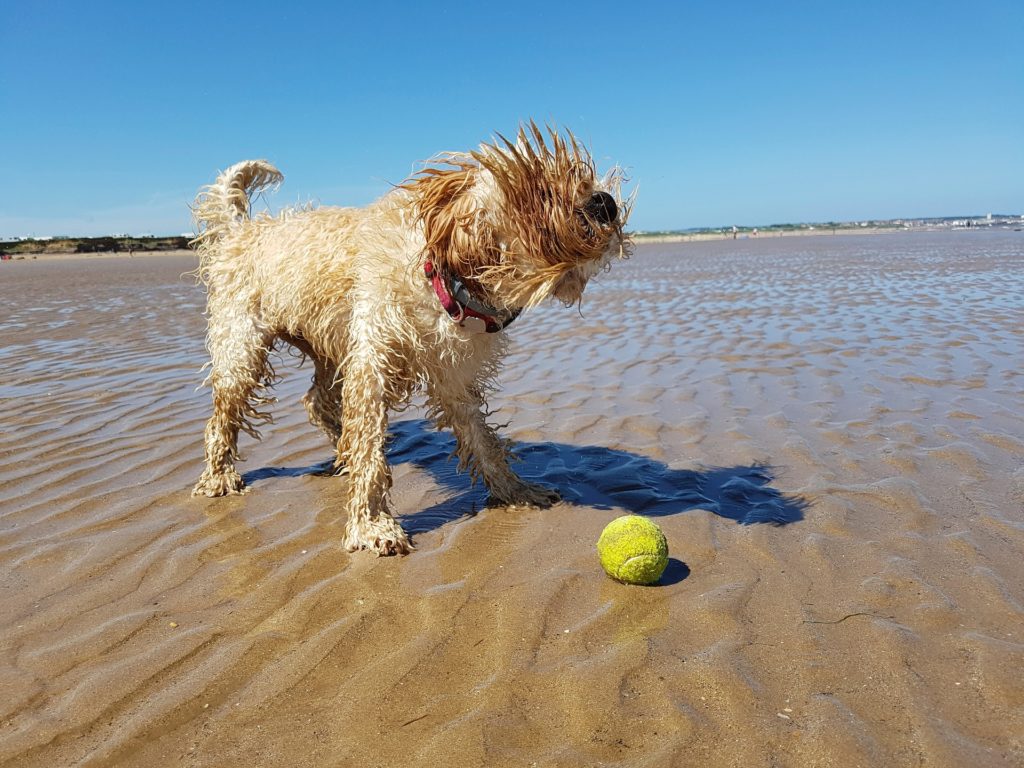
Dogs are probably the most complicated animal to deal with when going on holidays. You can’t just leave them at home with food and water. This is not only bad for your dog, but could also lead you to be accused of animal cruelty, as abandoning a pet is a serious crime in most states. The best option is definitely to book a seat for your dog in your car and help them pack their suitcase!
Why should I take my dog with me?
Of course you can leave your dog with your friends or family (preferably someone they already know). However, keep in mind that dogs are very social animals and thrive on their owner’s company. For them, holidays will be a fantastic opportunity to spend some quality time with their favorite humans. Moreover, since you are on holidays, you will have more free time and will be able to spend entire days with your dog, which will make them extremely happy. No more long and boring days waiting for you at home! No doubt that you and your family will also be delighted to spend the whole day playing and exercising with your dog. They can also help you to interact with fellow holiday makers: many people won’t be able to resist giving them some attention!
How to organize a trip with a dog
Here is a list of what you can do to make sure your dog is ready for the holidays and everything goes fine while you two are away from home:
- Before going, make sure your dog is used to traveling in a car. Some dogs can be car sick and it is good to prepare them, especially if you’re planning on a road trip and are spending a lot of time in the car!
- Make sure your dog knows some basic commands such as heel and sit. If they are able to go on a walk without pulling on the lead, it is even better!
- Check that their jabs are up to date, and if you’re going abroad, double check what the requirements are far in advance.
- Bring everything they may need: food, of course, but also a first-aid kit, their health record book, the lead, the food and water bowls, the crate, their favorite toys, some poo bags… It is very important to take your dog’s food with you if you are going abroad since you can’t make sure you’ll find their favorite brand in the country you’re visiting.
- While traveling, put your dog in their cage in the trunk of the car.
- Before visiting a place, make sure they accept pets. Never go to a hotel before checking it. Likewise, you will easily lists of dog friendly beaches on the internet.
- Check that your dog is not too hot. If you’re going on a walk, don’t forget to bring a bowl and a good amount of water.
- When settling your dog somewhere, do it properly: make sure they have some food, some water, some shadow… Even if it is just for an hour!
- If you think it is necessary, you can fit your dog with a GPS collar. This can be useful when you go hiking in the wild. You can also download various apps on your mobile to help you locate a lost dog, find a vets near you or keep record of your dog’s health.
- https://www.fleatickrisk.com/ is a very helpful website that will tell you if your dog is at risk of pest infections in the city you’re visiting. Check the website before going and take the necessary equipment with you.
PUBLIC TRANSPORT
In the US, you can travel for free with your pet on most public transport: buses, taxis, trains and ferries. However, to make sure everything goes smoothly, always check that that is the case before you board. Be aware that coach companies generally do not accept pets except for assistance dogs. Remember that passengers can complain about your animal’s behavior so try and make sure your pet will be able to behave themselves while traveling.
When traveling abroad, make sure you can go on public transport with your pet since this can vary according to the country (in some places you will have to book a ticket for your animal).
If you’re traveling by plane, mention that you have an animal when booking and check that your animal’s vaccination is up to date. On the day of the departure, make sure to arrive early. Cats and small dogs will generally be allowed to fly with you in the cabin. However, bigger dogs will have to travel in a heated and pressurized part of the cargo hold. Birds, rabbits and hamsters are often forbidden but some airlines may accept them.
This entry was posted in Pets
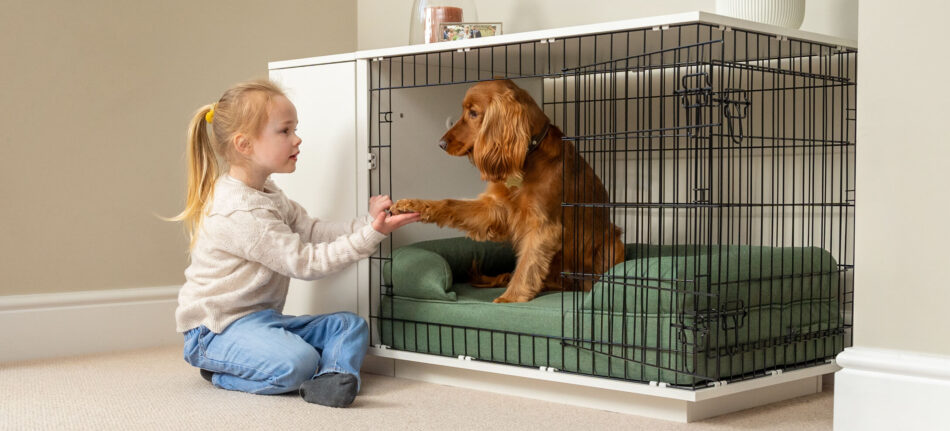
We all know that pets are not just animals, they’re members of our family. So for the pet parents who are also human parents, why not foster an even stronger bond between your children and four-legged friends by engaging them in exciting activities that promote laughter, joy, and unforgettable memories? Get ready to unleash the fun with this treasure trove of ideas that will ignite imaginations and provide endless hours of entertainment of engaging activities for your kids and pets to do together.
Bake treats for your pets
Kids love to help in the kitchen! And when they know their culinary efforts will end in a delicious delight for their favorite furry family member, they’ll be sure to raise their helping hands. Just make sure the recipe you choose for your pet is safe for them to eat, and abide by the same rule used with kids – treats are to be enjoyed on a limited basis.
Have a hamster in the house? Grab some of your pantry staples to make these yummy honey homemade hamster treats. For a tail-wagging breakfast, let your kids break the eggs and blend the bananas to make dog-friendly pancakes. The best part of this activity is that every member of the family can taste the treats.
Find new games to play with your cat
When the cat’s away, the mice will play. But when kids and cats are together, play is even better! Most cats love to play games because it mimics their natural instincts to pounce and bat with their paws. So before allowing your child to play closely with any pet, make sure they understand how to handle them safely.
An interactive game of chase with feathers, cat toys, or scarves makes for a fun-filled time for both kids and cats alike. Want to take the fun outside? Let your littles roam free together in a safely enclosed Catio while chasing bubbles all around. And for the senior cats who may find the chase games too much, encourage your child to stretch alongside their favorite feline on a sturdy cat scratching post.
Teach your dog a new trick
They say you can’t teach an old dog new tricks, but that’s simply just not true. With the right encouragement, some patience, and lots of love, your dog can learn new things at any age in life. And what better way for your kids and canine to spend some quality time together than with a fun new trick?
Summer is a great time to let your kids get involved in teaching Fido how to fetch a stick or even learn a new command like “sit and shake”. Make sure your child keeps plenty of dog treats in their pocket to give as a reward for the newly learned behavior. And because new tricks require lots of mental stimulation, make sure you have a comfortable and supportive dog bed where your furry friend can rest after all their hard work. By the time summer is over, your kids and dog will impress the whole family with all they have both learned.
Pocket money
Chores are a great way to teach your kids the importance of responsibility, but they’re also a great way to let your child earn some spending cash. And learning the value of work at a young age will always pay off later. So in an effort to get your kids and pets more time together while also completing needed work around the house, why not have them clean out the chicken coop to earn a bit of extra pocket money?
The Eglu chicken coops are so easy to clean that anyone tall enough to reach in and touch a hen will be able to get it spotless with ease. With a little bit of pet-safe disinfectant and water, your chickens’ home will be sparkly clean and hygienically healthy in no time. Plus, what kid doesn’t like to use a water hose? This simple chore of cleaning and collecting eggs not only allows your child more interaction with the hens, but it makes one less task for you to do. Win-win for everyone!
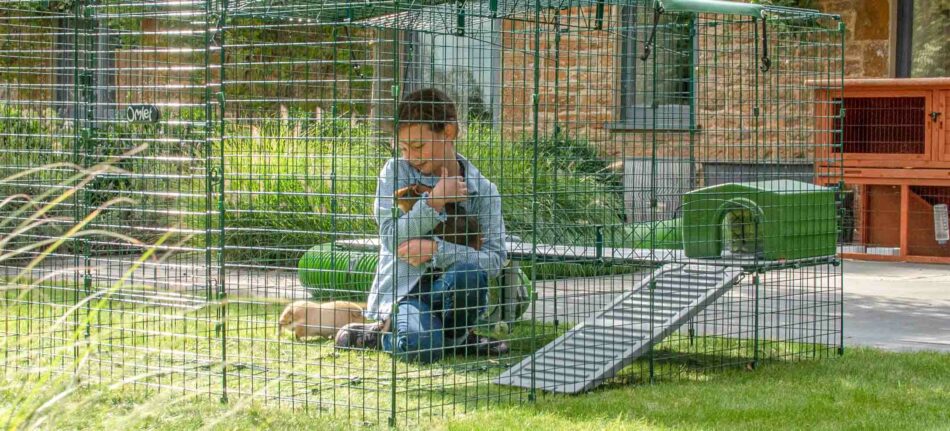
Homemade toys for rabbits
When it comes to fun for rabbits, Omlet has you covered. But if you’re looking for activities for your child and rabbit to enjoy together, look no further than your own backyard. One of the best ways to get everyone outside and having fun is to go on a backyard scavenger hunt. Have your kids locate a willow tree and collect some twigs to weave into a ball or a wreath. Your rabbits will love playing with their new toys as well as nibbling on the nutritious wood, and your kids will feel accomplished in creating a new rabbit masterpiece.
But the floppy-eared fun doesn’t stop there! If you’ve got an old towel or a ripped pair of jeans you’re getting rid of you can make a rag doll for your rabbits. Have your kids use their creativity to make something beautiful. Even just tying a knot in the middle of a strip of sturdy fabric will provide hours of fun for rabbits to tear apart in their outdoor rabbit run. Just make sure to take it away before they’ve ruined it completely – you don’t want them to ingest too much fabric.
Build an obstacle course for your hamster
Hamsters are the curious and energetic pets of the animal world. So engage both your child’s and hamster’s love of running, jumping, and climbing by helping your kids build an obstacle course for your hamster. Start by finding a safe area in your house where the hamster can be let out, away from open doors and other pets. You might want to build the course inside a playpen or create a barrier using books or other heavy objects. Just make sure they can’t fall over and hurt the hamster.
Have a LEGO-loving kid in your house? Get them to use their brick-building creativity to make the outline of the obstacle course. LEGO pieces will also make great jumps and steps for your hamster to navigate. Use clean popsicle sticks to build a ladder or a ramp for the hamster to climb up on, and build tunnels and hiding places with toilet paper rolls and cardboard boxes. Glue them together to create a hamster maze within the obstacle course and have your kids hide treats to encourage your hamster to explore.
Photoshoot
Capturing the bond between children and their furry companions in photos creates cherished memories that can be treasured for years to come. During a photoshoot, kids and pets can engage in various poses and interactions that showcase their special relationship. This activity not only allows kids and pets to have fun together but also encourages their creativity and self-expression. It’s also a great opportunity to teach children about patience, empathy, and respect for animals. Have fun with different locations and colorful outfits (if your pet obliges!) and make the photos as creative as you want. Here are our best tips for taking better photos of your pets.
Abstract paw art
If you have children, you likely have several crayon drawings hanging on your fridge. Why not add to the gallery with some abstract paw art made by your favorite furry child? Let your dog’s creative juices flow by helping your child work with your pup to create a beautiful piece of art.
Get some toxic-free, water-based paint and gently put your dog’s paws in it. With the help of some dog treats, guide your dog to a blank canvas and let them walk all over it, creating an abstract paw-print painting. You can even have your kids get in on the fun by adding their handprints as well! Be sure to have water on hand to clean everyone’s paws and best to do this activity outside to avoid the risk of paw prints on carpets and furniture.
Omlet brings kids and pets together
At Omlet, we know the bond between kids and their pets is a truly special one. Engaging in activities together not only strengthens their connection but also offers countless benefits for both of them. With our personal pet experience and ingenious expert designs, we create products for dogs, cats, chickens, rabbits, and more, that will bring out the best in everyone in the family. So try out one of these shared experiences with your kids and pets and create a lifelong friendship that will leave pawprints on their hearts forever.

This entry was posted in Dogs
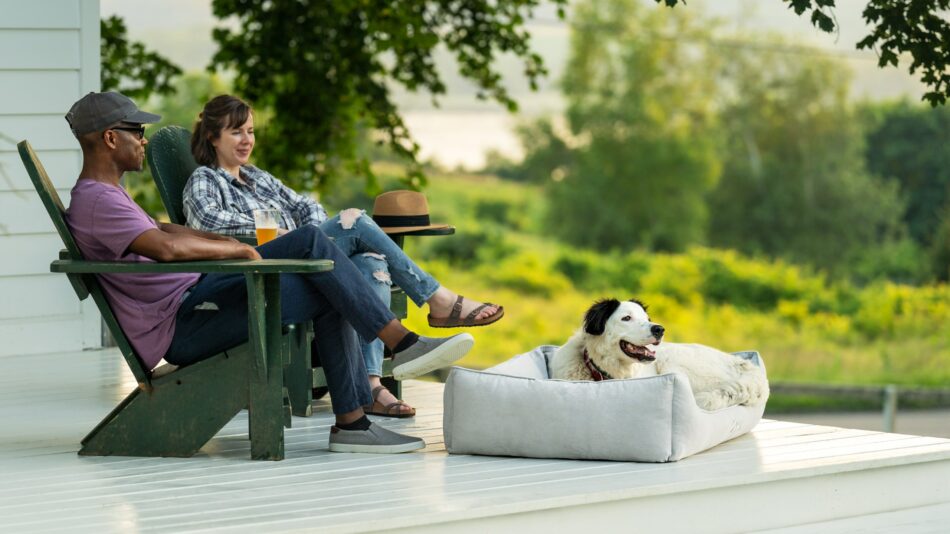
As any pet owner can tell you, animals have a wonderful way of weaving their way into our lives, bringing an abundance of joy, comfort, and a dash of adorable chaos. Owning a pet is more than just having furry, scaly, or feathered companions. Pets are the keepers of our secrets, the bringers of laughter, and the silent healers of our hearts. At Omlet, we think beyond the innovation of pet products and celebrate the remarkable bond that fosters people and pets. We recognize the benefits of owning a pet and know they are more than just a companion – they are an integral part of our lives, enriching them in countless ways.
Top 10 benefits of owning a pet
The decision to bring a pet into your life transcends companionship; it unlocks a myriad of benefits that enrich your physical, emotional, and mental well-being. From fostering responsibility to alleviating stress, the advantages of owning a pet are diverse and impactful.
Let’s delve into the top ten benefits of owning a pet:
1. Companionship and emotional support
The unwavering loyalty and unconditional love pets offer can alleviate feelings of loneliness and provide profound emotional support. Whether you are 2 or 92, pets offer comfort to our lives by giving us a sense of purpose and meaning.
Add fun products to your pet’s environment like a dome-shaped bird cage or a cat scratcher with lights and see how quickly your bond together strengthens. With wagging tails, furry coats or flocked feathers, pets become confidants, giving us comfort during difficult times, companionship through loneliness and a celebration of highs, making each day brighter.
2. Physical health improvement
Pet ownership often translates to increased physical activity. Whether it’s a dog needing walks or playing with an energetic cat, the regular exercise associated with pet care is tremendous. With increased exercise comes lower blood pressure, reduced risk of heart disease and a boost in overall fitness.
And don’t forget all the benefits your pet receives with movement as well as the increased bond they are getting with you. As a pet owner, you have your companion to thank for helping keep your health in check and happy.
3. Stress reduction
Have you ever had a stressful day only to come home, sit on the couch, start petting your dog and begin to feel more at ease? That’s because the mere presence of pets has been proven to reduce stress levels. There’s a reason pets are used as ‘calming mechanisms’ in hospitals, schools and nursing homes.
The simple act of petting a cat or dog triggers the release of oxytocin, or the “feel-good” hormone, in our brains which, in turn, promotes relaxation and decreases cortisol levels. And bonus – your dog or cat receives just as much happiness and satisfaction from being pet by you.
4. Enhanced social connections
Want more friends in your life? Get a pet. Pets serve as wonderful catalysts, easing social interactions among their owners. Whether it’s meeting fellow pet lovers at the park or engaging in conversations with neighbors during walks, pets act as the perfect icebreakers. Fostering new connections with pet owners is easy because they all have one thing in common – they love their pets like family.
5. Mental health benefits
The companionship of pets contributes significantly to mental health. They offer a sense of purpose, reduce symptoms of anxiety and depression, and provide a constant source of joy and entertainment, uplifting spirits during challenging times.
When feelings of depression or sadness abound, establishing new routines can be very beneficial in bringing about a general sense of well-being. With pets, routines are inevitable. Whether it’s the daily routine of walking your dog, scheduled feeding times or regular grooming schedules, having set plans for you and your pet makes mental health better.
6. Teaching responsibility
For families, owning a pet is an excellent way to teach children responsibility. Caring for a living being instill values within children like empathy, compassion, and accountability. By giving your child the responsibility of nurturing a pet, you will in turn be nurturing well-rounded individuals.
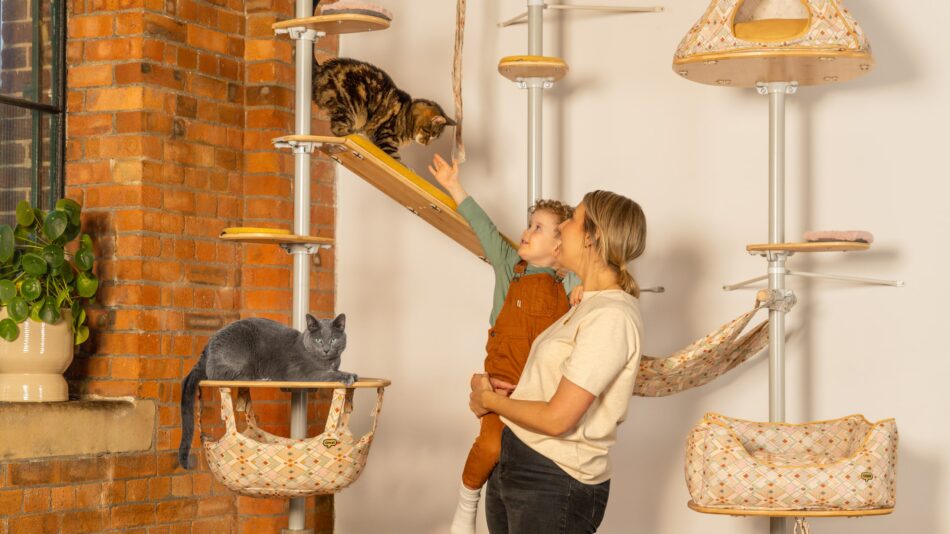
7. Improved immunity in children
While many people, and children, are allergic to certain animals, a lot of research has been conducted to suggest that early exposure to pets can actually bolster a child’s immune system. Pet hair and dander allergies are certainly real, however, the earlier a child is exposed to an animal, the greater the chance of reducing the risk of allergies and asthma.
In fact, growing up with pets introduces a variety of microbes to a child that they would not otherwise come in contact with and, as such, strengthens their immune system’s resilience. Always consult your doctor if medical conditions persist, but having a childhood pet is not just a memory maker, but an immunity booster as well.
8. Therapeutic benefits
The therapeutic benefits that pets offer to people are countless. From assisting in physical rehabilitation to providing comfort in emotional therapy, the presence of a pet can dramatically accelerate the healing process. While some pets are trained for specific service roles such as sight-seeing dogs, almost all pets can provide emotional support to their people just merely through their presence.
9. Sense of security
If you live alone or in a place where your sense of security feels weak, having a pet can make all the difference. Pets, especially dogs, offer a feeling of safety as they are another being in your house that can protect and provide reassurance. Dogs have keen senses and protective instincts, making owners feel safer and more secure with them around.
10. Unconditional love
There’s a quote by George Eliot that says, “Animals are such agreeable friends. They ask no questions; they pass no criticisms.” We would add that they are also one of the few beings that will love you more than you love yourself.
The joyous moments shared with pets leads to a profound sense of happiness and fulfillment. Through their antics, playful demeanor, and unwavering loyalty, pets offer us humans unconditional love and companionship that’s incredibly special and mutually beneficial.
Omlet and your pets
The relationship between pets and people extends far beyond the surface. Omlet acknowledges and cherishes this profound connection, recognizing the multitude of ways in which pets enhance our lives. That’s why we make products like the Geo Bird Cage and the Switch Cat Scratcher to enhance the unbreakable bond that is between a person and pet. Owning a pet is an enriching experience that contributes to holistic well-being, companionship, and happiness in immeasurable ways and Omlet is proud to be a partner in the care of your pet.
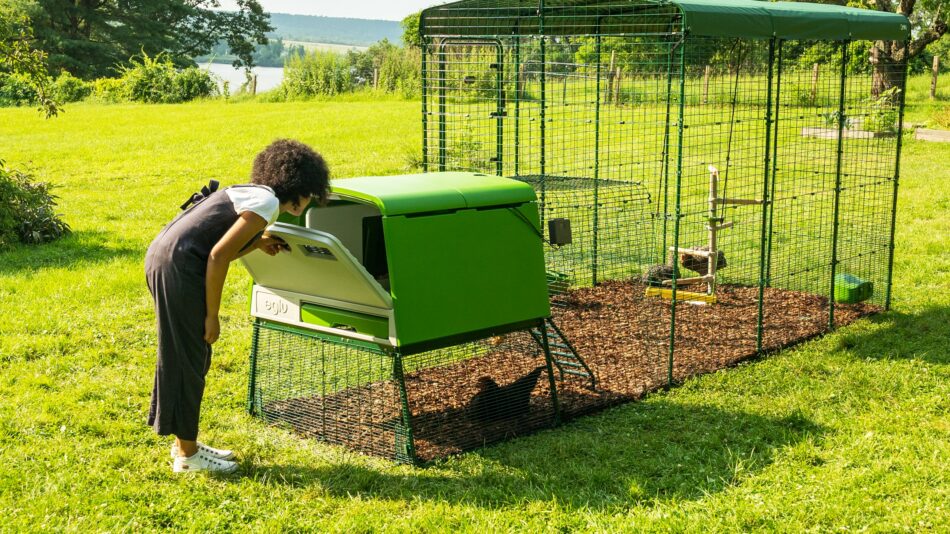
This entry was posted in Pets
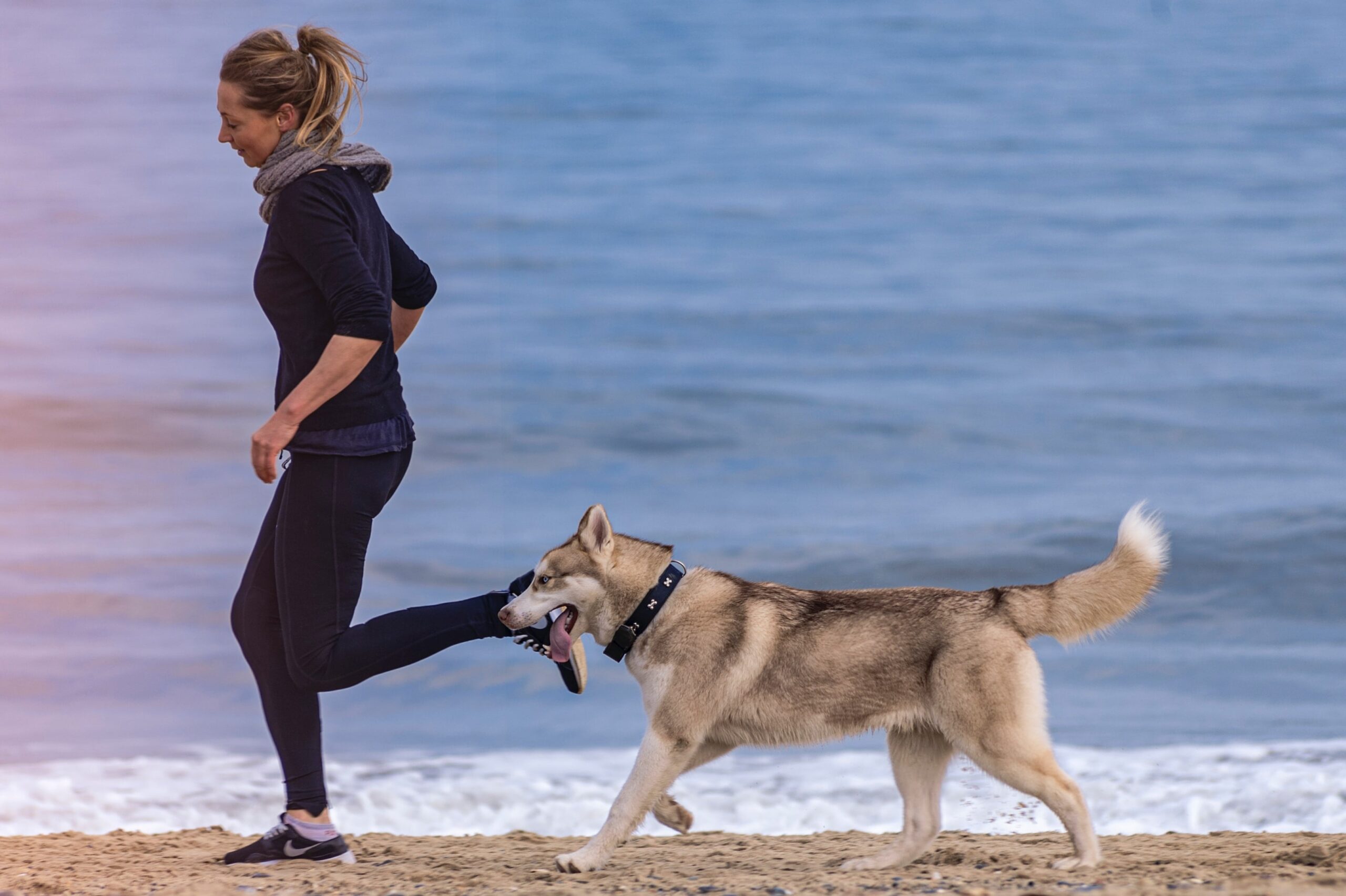
January is historically the month to set yourself some achievable goals for the year ahead. We’ve put together some ideas for creating New Year Resolutions for you and your pet!
Get fit
No more quick walks around the block after dinner. 2019 is all about getting fit with your pet. Both you and your pet will reap the rewards both physically and mentally. On an average 30 minute dog walk you can burn between 100 and 200 calories.
Try a new activity with your pet
From hiking to kayaking, hitting the waves to joining a pet exercise class, it’s easier than ever for people to incorporate their pet into a new pastime. These new activities will help you burn lots of calories! A 30 minute walk on the beach will burn approximately 150 calories and you could expect to burn 220 calories on a 30 minute hike.
Incorporate more playtime into your routine
Dogs love to play games and Cats love the thrill of chasing a toy; let’s just not tell them it’s exercise! Enjoy spending more time playing with your pets this year. A fun 20 minute tug of war would see you burn 50 calories.
Groom your pet every day
Brushing your pet helps to remove excess fur from their coat which reduces the amount you find on your clothes and furniture. It also helps distribute oils from the skin to the fur, to keep their coat healthy and shiny. Grooming an average sized dog burns 200 calories.
Teach an old dog a new trick
Studies show that mental stimulation can help reduce cognitive deterioration in older animals. By keeping your senior pet’s brain active, it can actually make it healthier.
Update your pet’s ID info
Over the course of a year, a lot can change — people move, get new phone numbers, and forget to update their pet’s tags. Don’t wait — update their tags and microchips now.
Make new friends
Visit your park and get to know other pet owners! It’s easier that you think!
Maintain a healthy diet
Lead a healthy life with a balanced diet and not too many treats.
Most of all; enjoy spending time with your wonderful pets!
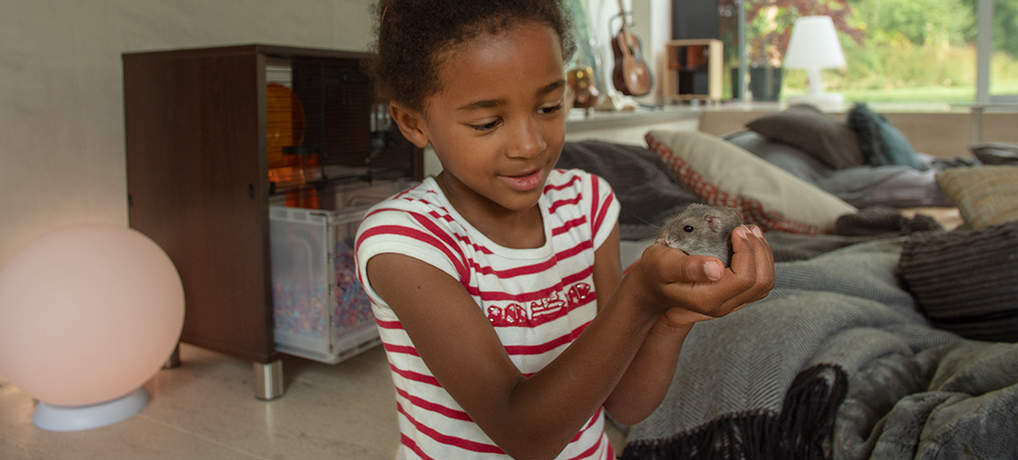
This entry was posted in Pets
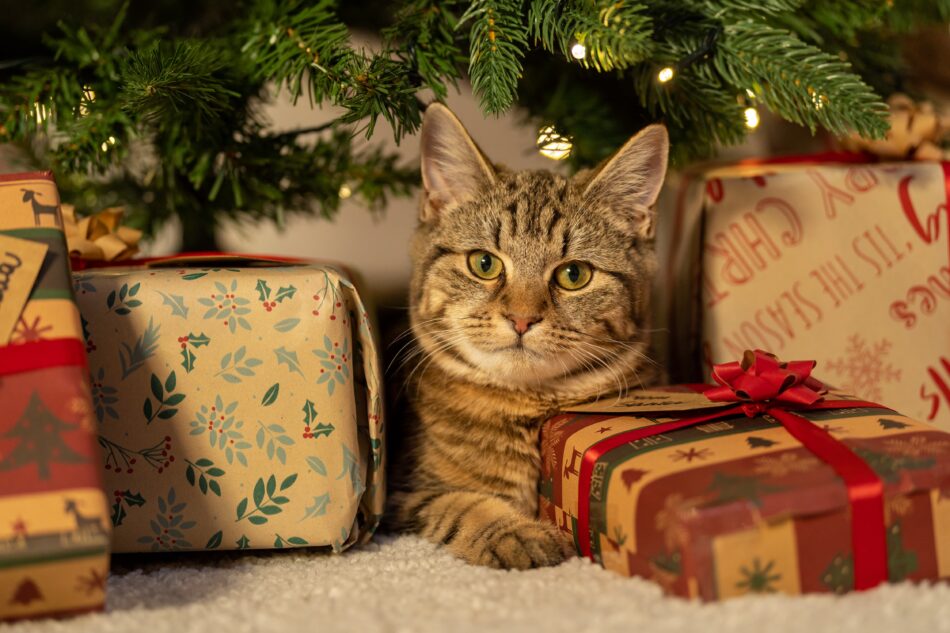
Christmas is a wonderful time of year, and we’re all looking forward to celebrating together with our loved ones, including our pets! It’s therefore important to consider what effect all the festive fun is having on our furry friends, and to make sure they’re also having a great time. Here are some of our top tips for keeping your pets safe and happy this Christmas!
Limit treats
We know it’s much more difficult to resist feeding scraps to your pets over Christmas, but in most cases, it’s really not good for them, and can even be harmful. Instead, we suggest that you spend this special occasion making the most of plenty of quality time with your pets. They’ll without a doubt prefer your company to treats or presents! For a guide of what you can feed your dogs this Christmas, take a read of our blog Happy Howlidays: Food Do’s and Don’ts for Dogs This Christmas.
Keep routines
Try to stick to the normal schedule as much as possible over the holidays, especially when it comes to mealtimes. Our pets don’t understand that we have got lots to do during this time after all, and a disruption of their routines will add to a possibly already stressful time. Let your chickens out at the same time as usual, walk your dog as you would normally and give your cat their daily play time.
Give your pets a safe space
Christmas can get hectic, so make sure your pet has somewhere to go to get away from all hustle and bustle, preferably in a different, quieter, room. If you’ve got guests coming over, let them know what to do, and what not to do, around your pets. It’s important that everyone knows what doors, windows and gates need to be kept closed, what the pets are allowed to do and eat, and when they are to be left alone.
Going away
If you’re spending Christmas somewhere else, you need to take your pets into consideration. Don’t leave them alone for longer than they are used to, and make sure they’ve got what they need while you’re away. If you’re taking them with you, bring something that will remind them of home, like a cat blanket, dog toy, or their hamster cage. If you can’t take them with you, you will need to find an alternative solution.
Make sure you plan the journey and be aware of the fact that traffic can be busy around Christmas. Your pet must have access to food and water at all times, and depending on your what pet you’ve got, there might be a need for toilet breaks.
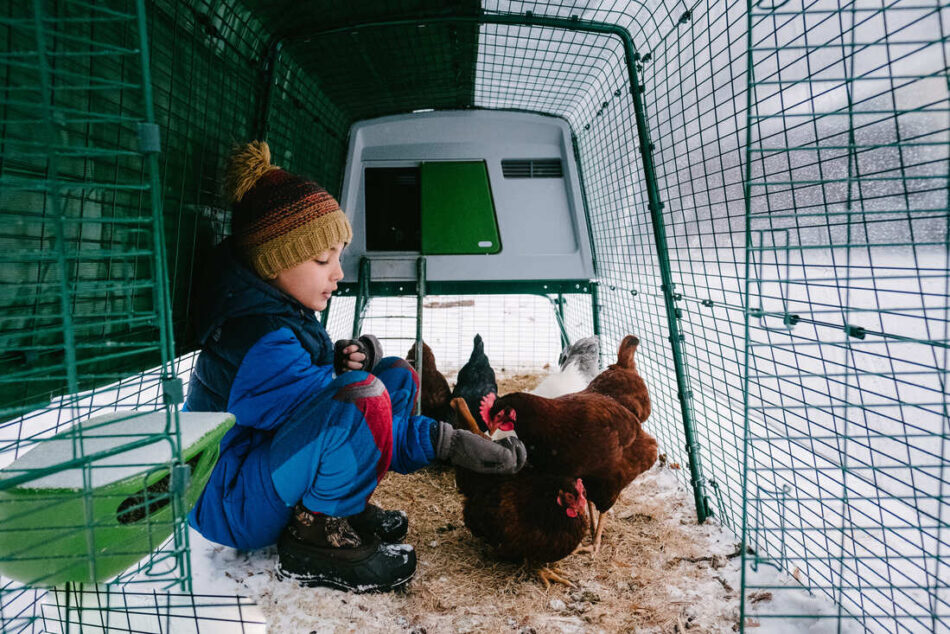
Christmas trees and plants
Make sure your Christmas tree if safely secured, as cats tend to try and climb them. It might also be a good idea to hang especially intriguing and tantalising decorations higher up in the tree where pets can’t reach them as easily. This minimises the risk of cats getting tangled and the tree falling over.
Hoover under and around the tree regularly to get rid of fallen pine needles. The needles can get stuck in mouths or between toes, which can be very painful.
Lots of our most common Christmas plants, including poinsettias, mistletoe and amaryllis, are poisonous to a lot of pets, so make sure you stay clear of them, or keep them out of reach.
Decorations and presents
Choose non-toxic Christmas decorations and keep cables from lights and other decorations out of reach. Should your pet try to nibble through them, this can cause damage to both cable and pet.
Don’t leave presents containing eatable things (chocolate in particular!) under the tree. It will soon be sniffed out, and it won’t take a couple of greedy paws long to get into a wrapped present.
Once the gifts have been opened, clear away the wrapping paper straight away. Not only will you avoid having paper all over the room once your pets get to it, but coloured paper and string should also not be ingested by pets.
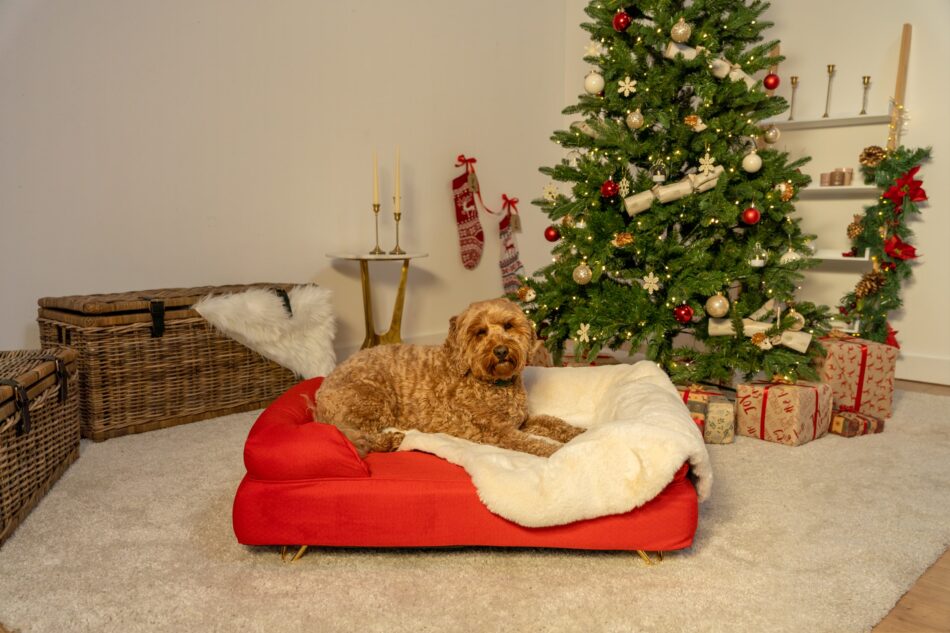
This entry was posted in Pets
If you’re looking to get some great shots of your furry or feathered friends, follow these tips so that you can master the art of the perfect pet pic!
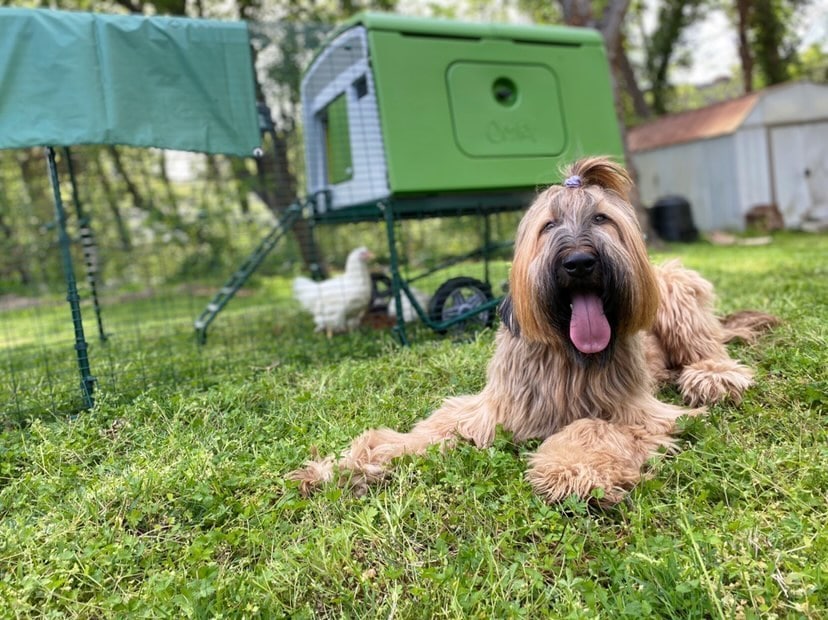
Patience
The first thing to remember is that pet photography requires patience. It doesn’t matter if you want a posed photo of your rabbit or an action shot of your dog, you’re probably going to get rather frustrated when your models are not behaving in the way you want them to. So arm yourself with patience, and never force your pet into doing something they don’t like.
Get help
If you have a family member or a friend at hand, it’s always useful to ask them to assist you. They can use toys or treats to get the attention of the pet and direct their gaze while you focus on getting a great photo. If you’re by yourself you’re going to have to find other ways. Sometimes making a sudden noise can get the attention of the pet, but probably only for a second or two, so make sure you’re ready. Depending on the type of photo you’re after it might be easier to have the photo session after you’re played together for a while and the pet is less excited and bouncy.
Use natural light
If you’re not a professional photographer with access to different lenses and flashes, you’re probably going to want to take advantage of the natural light. Try starting outdoors, or if you’re indoors, by a window. The light will make the photo look better, and will give you more freedom to experiment. We would suggest going somewhere where both you and your pet feel comfortable, maybe a place that means a lot to you and where you have created lots of memories together. Try to choose a place with a relatively clear backdrop, like a while wall or a grassy field, as a messy background can be distracting.
Try to focus on the eyes
If the eyes are blurry or out of focus the photo will look slightly off. The camera will automatically focus on what is closest to the lens, which in most cases will be the nose of your pet rather than the eyes. This is especially important when you’re taking close ups.
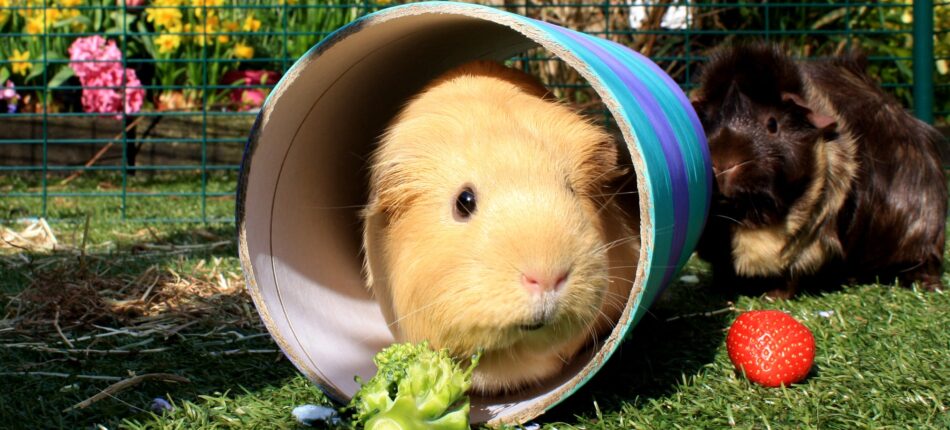
Get down to their level
This might mean you have to crouch down in the mud or crawl on the floor, but in return your photos will be significantly more unique and interesting. Try taking photos from different angles: from above, below, in front of your pet, behind it. You’ll get to see your pet from all sides, and sometimes the photos from the weirdest of angles are the ones you will love the most.
Have their personalities in mind
The whole point of taking photographs of your pets is to try and capture their personalities, so try to make sure that their characters are showing in the photo. If you cat is the lazy ruler of the house you probably want to capture it yawning in their favorite spot on the sofa, and if you have a dog that bounces around the house and is impossible to tire, you probably want to capture its liveliness in the middle of a jump or running towards you in the park.
Quantity is key
The more photos you take, at different times and locations, the more likely you are to get that one amazing shot. This will also mean that you get loads of photos of your pet in different places, moods and positions. Get used to taking photos when you’re out on walks, playing in the garden, or just relaxing at home, and try to spy on your pet to catch what they’re doing when you’re not around. And remember to always take 20 photos instead of just one.
Use treats
If you’re trying to have a properly arranged photo shoot, try using treats. Depending on what pet you have, and their personalities, offering treats can make them sit still and look at the camera. Others will just walk up to you to get the treat, or ignore the treat completely, but it’s worth trying. Make sure that you reward your model throughout the shoot.
Include props
Props go a long way when getting a great picture of your pet. Not only are they a great way to make your shoot more fun, but they can make your pet look even cuter! Why not feature some of their favorite pet toys and accessories in the background of some of your shots, or you can even smarten fido up with a fun dog bow-tie and adorable dog fleece. Of course, it again goes without saying that if your pet doesn’t feel comfortable with any props you’re using, then stop using them. Remember – no one likes a pushy petographer!
Add humans to the photo
Having family members in the photos with your pet makes the pictures even more special, and they are the ones that you will come back to and look at. A photo of your child playing with your dog or feeding the chickens will capture their characters in a way that a posed photo very rarely does.
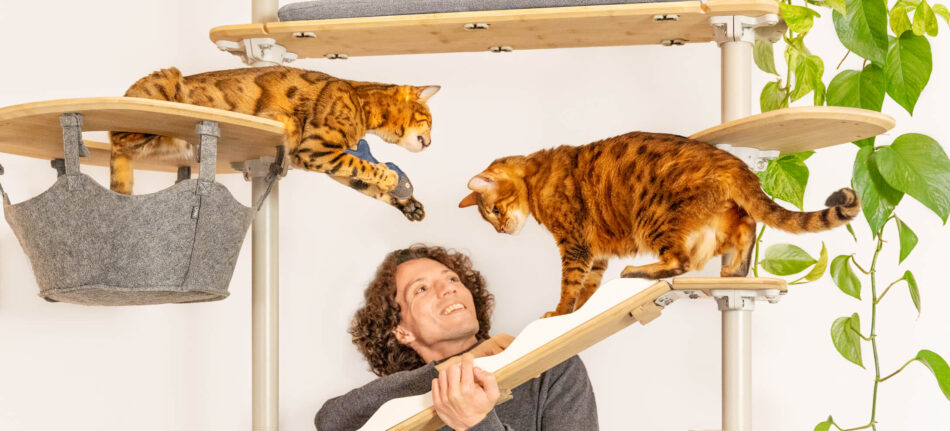
This entry was posted in Pets

Keep it fair and fun
Avoid arguments between children by color coding the hunt, give each child one color that they need to search for. Alternatively if you have a broad range of ages playing, why not color code the hunt based on ages, younger children can look for the large gold eggs whereas the older children need to look for the pink eggs which you will have made harder to find.
Provide alternatives to chocolate
Think ahead about who will be participating in your Easter Egg Hunt? Are any of the children diabetic? Are they allergic to dairy, gluten, cocoa or nuts? You could always use plastic decorative eggs for them to find then have prizes such as coloring books or toys instead of the sugary treats.

Remember the baskets!
The children will need something to carry their eggs in, lots of craft stores have cute baskets you can use or alternatively you make them as an activity before the hunt. See here for a guide on how to weave your own basket.
Think of fun clues
If you want to add another fun element to your hunt, you could think about providing the kids with clues as to where the eggs are hidden, such as “Somewhere that’s cold (fridge)” “What shall we have for breakfast? (cereal box)”, “It’s raining outside, what shall we take with us? (umbrella stand).
Keep track of your hiding places
It’s worth making a note of the hiding places and the number of eggs hidden for your own reference.
Check the weather forecast
Firstly so you’re not planning to commence the hunt when it’s due to rain, also if you are hiding chocolate, double check the temperature forecasted as you might need to make sure they’re all hidden in shaded areas, or you don’t put them out too early before it kicks off. Noone wants a melted Easter egg! If the weather is going to be stormy, plan a backup hunt for inside the house.
Set boundaries
Let the kids know where the searching area is, it’s important to make sure everyone has fun but in a safe environment. Show the children where the start and end of the hunting zone is.
This entry was posted in Pets
Running your own course is a fulfilling and rewarding way for you to share your hobby. Whether you keep chickens, rabbits, guinea pigs or another type of animal in your Eglu you can apply to set up your own course.
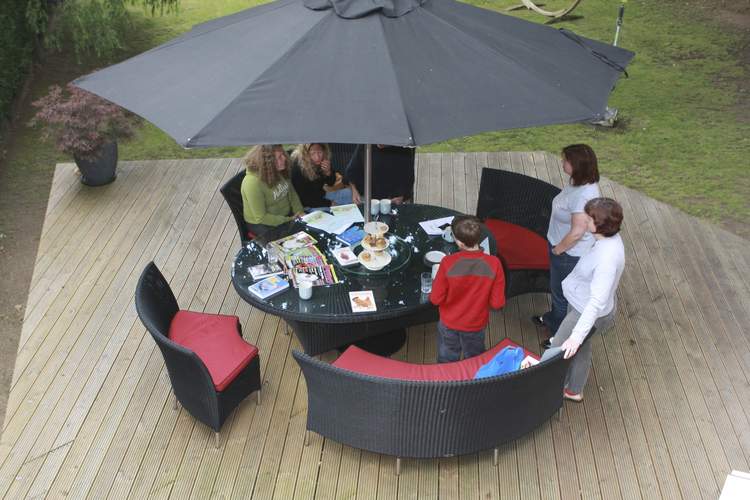
We like to encourage the best duty of care for animals therefore we encourage our more experienced customers to share their knowledge with new starters. Particularly when it comes to keeping chickens. In recent years backyard chicken keeping has massively increased in popularity although lots of people still don’t know how to get started or they’ve put off getting their own flock as they’re not too sure how much care and upkeep it entails. Whilst you can easily watch a Youtube clip or read blogs to get a better idea, nothing beats face to face and hands on teaching.
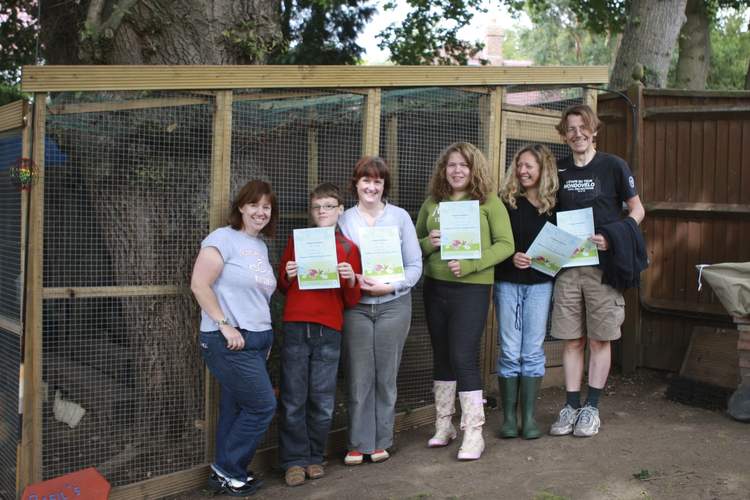
How much you charge for your course is entirely up to you, you need to analyse and value what you think your course is worth, for a 2 hour beginners guide to chicken keeping we would recommend charging $30 per attendee depending on what you provide the attendees with (refreshments, pamphlets, guidebooks, printouts.) Courses are booked through the Omlet website and you must have an Eglu to qualify to host a course.
The courses you host don’t have to be very long they could simply be an afternoon or evening, designed to appeal to a range of ages. We recommend offering a form of refreshments for your course attendees when they arrive, a really nice touch is to perhaps bake something using your farm fresh eggs to demonstrate how great they taste. We would then suggest telling your attendees a bit about your background story and how you got into chicken keeping and how it has affected your lives. Ideally the weather will be good so you can take your guests out to your Eglu coop to demonstrate how to use it.
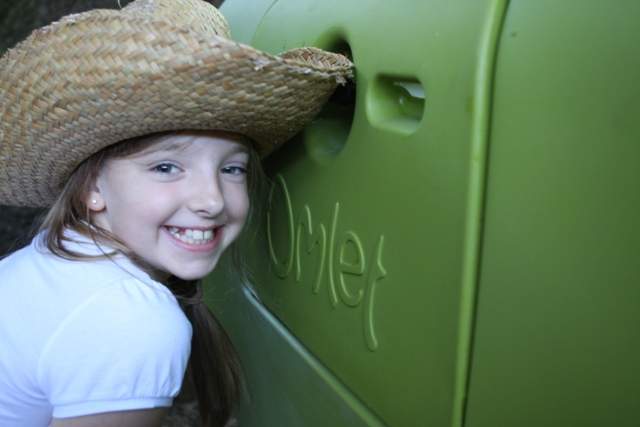
You will then want explain the needs of chickens, their daily, weekly and monthly needs. How to care for chickens, what to look for if you think a chicken is poorly, different weather conditions and how to alter your chicken care, supplements, cleaning, how to store eggs etc.
Perhaps offer them the opportunity to ‘hug a hen’ and see what nice and friendly animals they are. A good way to round off your course is a Q and A session so people have the opportunity to ask you the questions the internet has not been able to answer for them. You don’t need to know the answer for all of them, it can become a discussion and all you can do is offer them your best advice from you experience and wisdom.
To apply to become a course host and receive more information either login or create an Omlet account here and then click on the Courses section of the portal.
This entry was posted in Pets










 Naming pets can be difficult. Should you go for something highly original, something that describes the pet, or something that reflects your own personality? Should it be ‘safe’, picked from an online list of popular pet names? Or should it say something about the year the pet was born – perhaps a dog called Trump, a cat called Greta, or a budgie called Boris?
Naming pets can be difficult. Should you go for something highly original, something that describes the pet, or something that reflects your own personality? Should it be ‘safe’, picked from an online list of popular pet names? Or should it say something about the year the pet was born – perhaps a dog called Trump, a cat called Greta, or a budgie called Boris? Things To Avoid
Things To Avoid








 Special Notes For Cats
Special Notes For Cats



 CHICKENS
CHICKENS


















